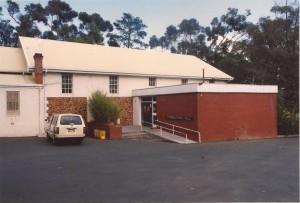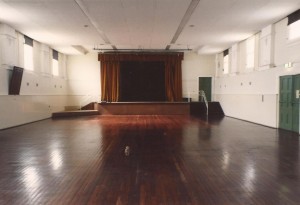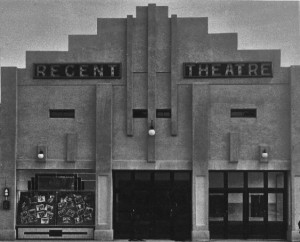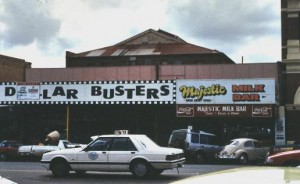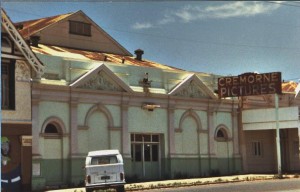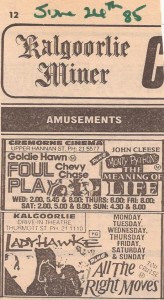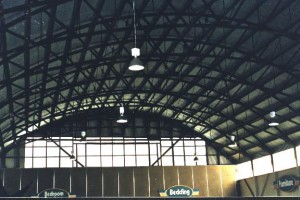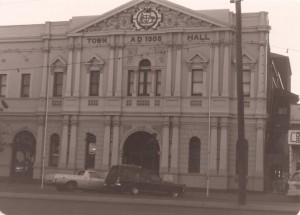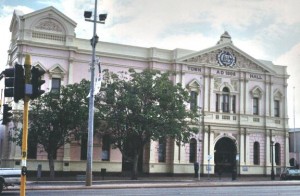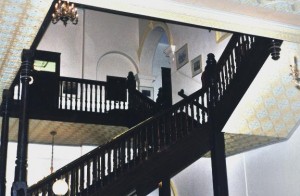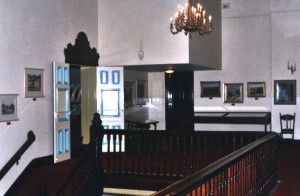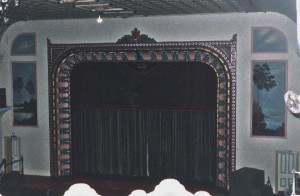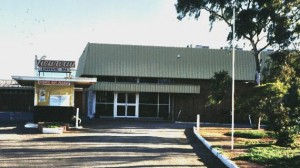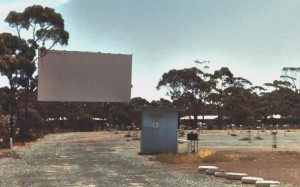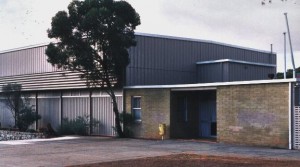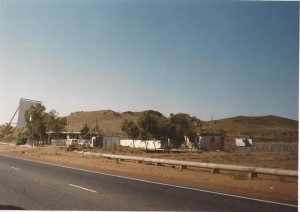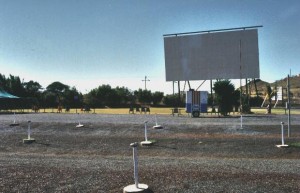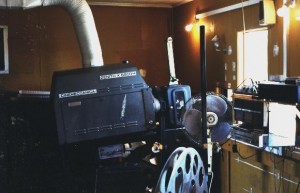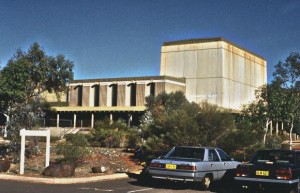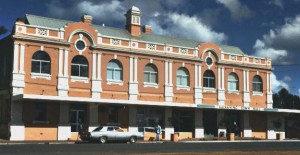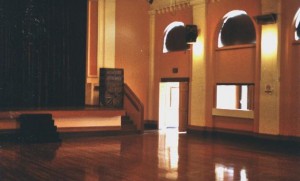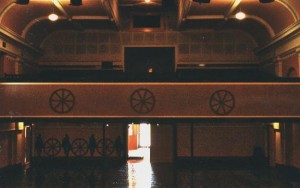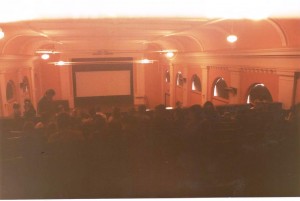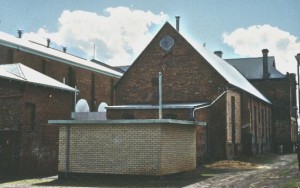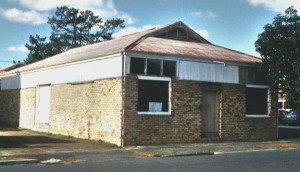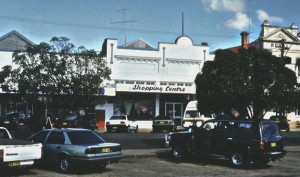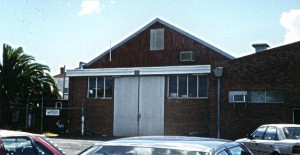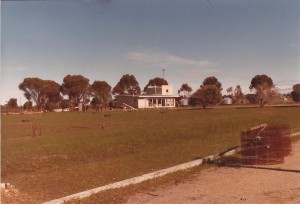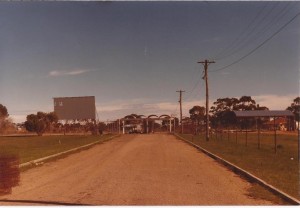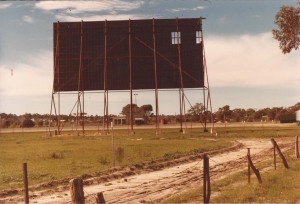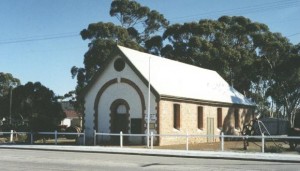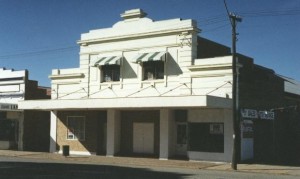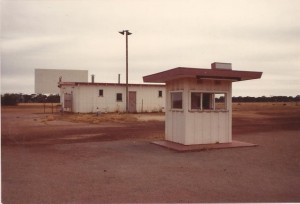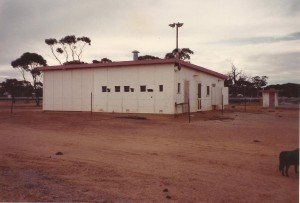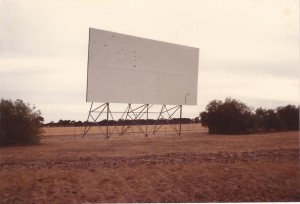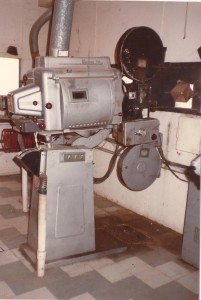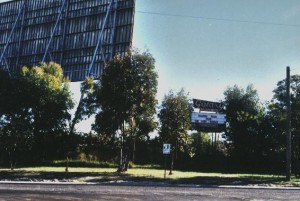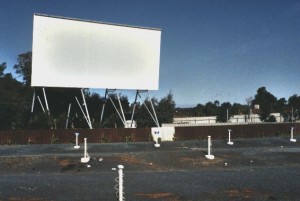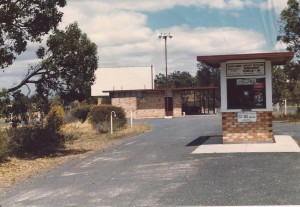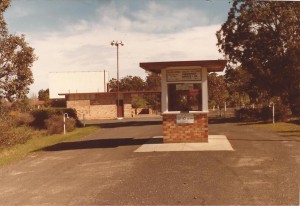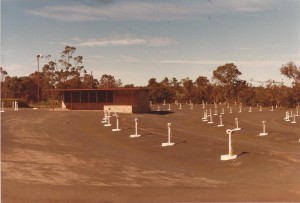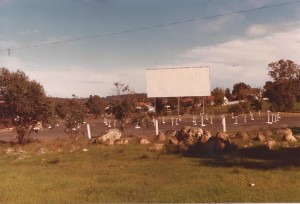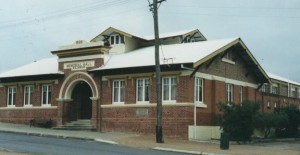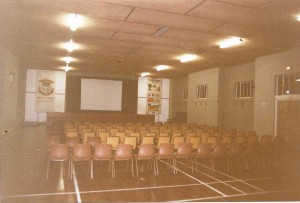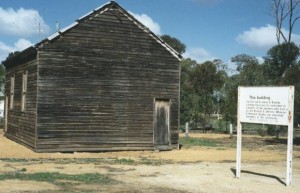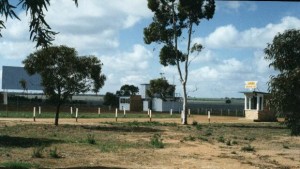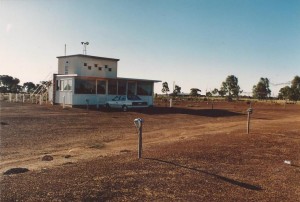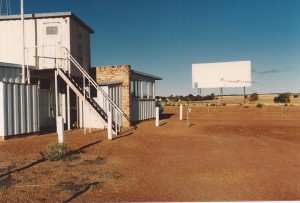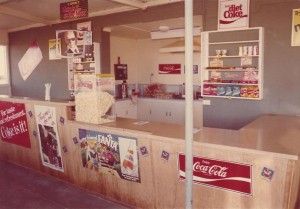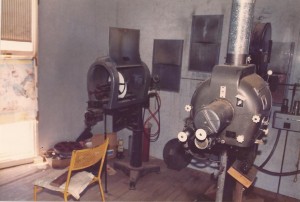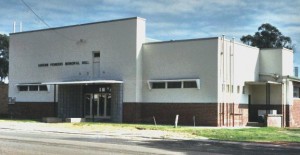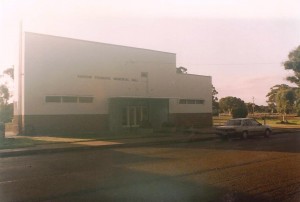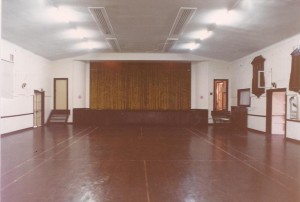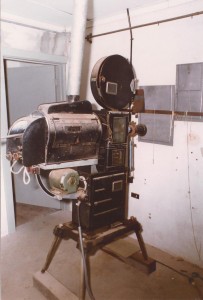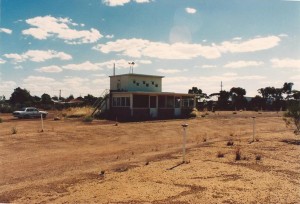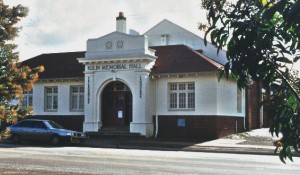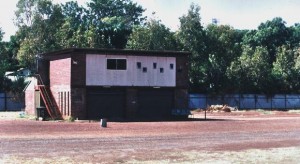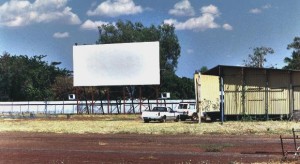Quicklinks
KALAMUNDA
KALAMUNDA HALL AND GARDENS, Kalamunda
Kalamunda Historical Society describes (1982, p.14) how the original Agricultural Hall was the first brick-built structure in the district, which, till 1901, was known as Gooseberry Hill. This hall was built in 1896 by the Darling Range Vine and Fruit growers Association, and used as a meeting place for the Darling Range Road Board in 1903-4, as a school room occasionally, and for all the usual social occasions. Seating was on wooden forms at first, then on bentwood chairs, and the hall was lit with oil lamps.
In 1922 the Darling Range Road Board bought the Agricultural Hall and renamed it the Lesser Hall when they incorporated it within a new building, opened in 1923. The original hall was known as either the Lesser Hall or the Agricultural Hall: screenings were advertised in the Lesser Hall in 1922-1923, and in the Agricultural Hall 1927 and 1936. The venue was on Bart Mott’s Star Entertainments circuit from the early forties to the middle fifties, then for a few years by A.E.Randell. The Heath Rd Picture Gardens was opened around 1953, on land opposite the Kalamunda Storage Agency. It is not clear whether the hall screenings and the gardens screenings were connected, but both had ceased by the early sixties.
Further alterations were made to the buildings in 1968 (new entrance and toilet block) and 1975-6 (new roof and kitchen block).
Sources: Film Weekly Directory 1940/41 – 1961/2
Max Bell, Perth – a cinema history, The Book Guild, Lewes, Sussex, 1986, p.31
Max Bell, ´Kalamunda cinemas, 1922-1959′, Kino no.42, December 1992, p.15
Kalamunda & Districts Historical Society, The Changing face of Kalamunda, 1982, & vol.2, 1987
Kalamunda & Districts Historical Society, A line on Kalamunda, co-ordinated by Gerry Brown, compiled & edited by John Harper-Nelson, The Nine Club 1978
West Australian, 1947 – 1958
Photos: 2 exteriors, b&w, 1898 and 1982, Kalamunda & Districts Historical Society, The Changing face of Kalamunda, 1982, p.14 (Agricultural Hall/ Lesser Hall)
2 exteriors, b&w, 1950s, 1987, Kalamunda & Districts Historical Society, The Changing face of Kalamunda, vol.2, 1987, p.31 (main hall)
1 exterior, colour , 1991, Roy Mudge
1 interior, colour, 1991, Roy Mudge
KALANNIE
OPEN AIR PICTURES, Kalannie
One informant can remember watching pictures at Kalannie when she was five years old, in the thirties. The screen was just a sheet tied on to the pile of wheatbags stacked ready for shipment in the railyard, and people sat on whatever they had brought with them. Obviously this could only happen in fine weather, and in summer if the wheat was to be used in this way. This was on the Fitzgerald circuit in the early fifties, then on Lew Punch’s wheatbelt circuit from about 1952 to 1961.
Sources: Film Weekly Directory 1950/51 – 1960/61
KALGOORLIE
CENTRAL GARDENS/ TOWN HALL GARDENS/ REGENT AND GARDENS, 328 Hannan St, Kalgoorlie
Central Gardens, on the south-west corner of the intersection of Hannan and Wilson Sts, opposite the Town Hall, opened 26 October 1911, with Radio Pictures’ screening of The Bush King or Captain Midnight, under the direction of Cozens Spencer. Radio Pictures then moved to the Cremorne Theatre in the winter of 1912 and back to the Central Gardens the following summer, and continued to be listed as occupier of the Central Gardens site in the Rate Books till 1914. After that, the site does not appear to have been in use for films for the next twenty years.
Bot Clemenger screened at the Town Hall in the twenties and thirties, and in 1926 bought the site opposite the Town Hall, for an associated gardens, but this first structure burned down.
After he formed Goldfields Pictures in 1933, the new company built the Regent Theatre on the gardens site, facing Wilson St, though its postal address was still Hannan St. The facade was divided into three sections: that on the left was a showcase for advertising present and forthcoming attractions, that in the middle provided entrance to the foyer (and thence to the theatre), and that on the right was both a ticket box and the entrance to the new gardens built next door (in Wilson St). The biobox was situated above the right hand corner of the theatre facade, so that projectors could be used from there either to the theatre screen (in the middle of the far wall), or to the gardens screen (on an angle across the far corner of the gardens). The venue was equipped with Raycophone sound gear from the start, replaced by Westrex after World War 2.
The whole site was sold in 1974, the buildings demolished and a Woolworths supermarket built there.
Sources: Municipality of Kalgoorlie rate Books 1910-1928
Film Weekly Directory 1940/41 – 1966/7
Post Office Directories 1930-1935/6 (Town Garden Pictures), 1937/8-1949 (Regent and Gardens)
Max Bell, Perth, a cinema history, The Book Guild Ltd, Lewes, Sussex 1986, p.120
Kalgoorlie Miner 1911-2
Interview (Ina Bertrand): Ron Elsegood (1985)
Interviews (Colleen Pead): Noel Dunning (1986), Ted Moore (1986)
Photo: 1 exterior, b&w, 1936 (Ron Elsegood)
1 exterior (Paddy Hannan statue with Regent and gardens in the background), b&w, 1950s?, Eastern Goldfields Historical Society (also in Stage, Screen and Stars, West Australian, n.d. (1997?), p.48)
MAJESTIC, 110-112 Hannan St, Kalgoorlie
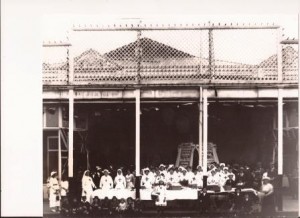
The Majestic was built by James Connolly, the third of his Majestic circuit (after Perth and Fremantle). It opened on the north side of Hannan St, halfway between Porter and Maritana Sts, on 26 May 1917 with a five-day season of Intolerance, screening twice a day (3-6 p.m. and again 7.30 – 10.30 p.m.). The official opening took place on 2 June 1917, with takings donated to the Red Cross. After that, continuous pictures were offered each day from 11 a.m. to 11 p.m., as in the other Majestic Theatres. Harrie (also known as Harry) Delavale was the first manager for the syndicate. It was a renovated building, formerly McKays Clothing Emporium, holding 1100-1200 people:
Visitors who have inspected the building during the past few days expressed the opinion that it is one of the best picture halls in the State, and that it compared favourably with those in the East. A feature that occasioned favourable comment last night was the comfortable seating accommodation. The padded leather seats are uniform throughout the building. It is claimed that the building will be cosy in winter and cool in summer. The ventilation has received special attention, and many electric fans have been installed in order to keep the air fresh and cool. There is easy access to the seats in all parts of the building, so that latecomers at any session will not have to disturb those already seated. (Kalgoorlie Miner, 2 June 1917)
The front wall of the cinema was set slightly back from the street frontage of neighbouring shops, with an external ticket box in the centre, flanked by entrance doors. These led into a foyer, with the bio-box situated above it and the manager’s office to the left of the entrance.
From 1920 J.C.Williamson’s leased the theatre and Robert Burley managed it for them. In 1926, Connolly sold it along with the rest of the Majestic chain to Hoyts who in 1928 sold the Kalgoorlie Majestic to Nelsons. Australtone sound equipment was installed in late 1929. Nelsons sold on to Goldfields Pictures in 1933, and at that time the theatre had ramped seating at the back, and deckchairs in front. It was not used regularly for evening screenings, but rather for matinees for shiftworkers three afternoons each week, and in winter it was used in conjunction with the Cremorne for big films (switching between the two). The café, operated by the Kalaf Brothers, was demolished in the race riots of January 1934, but rebuilt soon after.
After Goldfields sold the venue in 1975, it was gutted for use as a hardware store, but the original construction was still clearly visible inside, and the brick walls and corrugated iron roof of the original building were still visible in the 1990s above the shop fronts.
There was a Majestic Gardens a block further west, between Maritana and Cassidy Sts, south of the Post Office and Chamber of Commerce, advertised only for a short time in October-November 1917: this may have been a brief attempt to operate a gardens in association with the Majestic Theatre, but for the rest of its long life the Majestic had no associated gardens.
Sources: Municipality of Kalgoorlie Rate Books 1917 – 1928
Film Weekly Directory 1940/41 – 1971
Max Bell, Perth, a cinema history, The Book Guild Ltd, Lewes, Sussex 1986, p.113-4
Chris Wood, Kalgoorlie Historical Society
Everyone’s 25 April 1928 p.26; 23 October 1929, pp.18-19
Kalgoorlie Miner 1917-1925
West Australian 9 December 1916
Interviews (Ina Bertrand): Ron Elsegood (1985)
Interviews (Colleen Pead): Noel Dunning (1986), Lou Roe (1986)
Photos: 1 exterior Opening Night 1917 courtesy of AMMPT
1 exterior, colour, 1997, Graeme Bertrand
1 exterior (ticket box, Kalaf’s shop), b&w, n.d. (1930s?), Museum of the Goldfields no.17731 exterior, b&w, n.d. (1930s?), Museum of the Goldfields no.136-08
1 exterior (Red Cross stall at entrance), b&w, 1917, Museum of the Goldfields no.1104
1 interior (audience), b&w, n.d., Museum of the Goldfields no.1154
MINERS INSTITUTE, Hannan St, Kalgoorlie
The Miners Institute was opened in 1895, on the north side of the Post Office in Hannan St, and was used by the local Council till 1897. It was a substantial two-storey brick building with ornamental verandahs on both levels, shops on the street frontage and offices above. A galvanised iron hall was added in 1896 at the rear of the main building: in 1904 this hall became the billiard room.
The railway from Perth was opened in 1896, and by early 1897 theatrical companies were travelling by train to the lucrative goldfields market. The railway also made the transport of films from Perth feasible, so films were screened occasionally in the Miners Institute hall. The first, advertised in the Kalgoorlie Miner on 18 March 1897, seems to have been part of a vaudeville performance of the Olde Englishe Fayre Company. Other companies screened occasionally in the hall up to about 1900 or 1901, including possibly the Salvation Army Limelight Department, before other venues became more popular. The building later became known as the Mechanics Institute.
Sources: Kalgoorlie Miner 1896-1901
Robert Pascoe & Frances Thompson, In old Kalgoorlie, Western Australian Museum, 1989, pp.183-6
Martyn Webb & Audrey Webb, Golden Destiny: the centenary history of Kalgoorlie-Boulder and the Eastern Goldfields of Western Australia City of Kalgoorlie-Boulder, 1993, p.570
Limelight Picture Show Tours, http//:www.abc.net.au/limelight/docs/tours
Photos: 1 exterior, b&w, n.d. (1896?), Martyn Webb & Audrey Webb, Golden Destiny: the centenary history of Kalgoorlie-Boulder and the Eastern Goldfields of Western Australia, City of Kalgoorlie-Boulder, 1993, p.572
1 exterior, b&w, 1989, ibid., p.772
1 interior (billiard room), b&w, n.d., Museum of the Goldfields (reprinted in Hannan St, Kalgoorlie, “Our Golden Heritage”, Kalgoorlie-boulder Tourist Centre, June 1995)
POST OFFICE PICTURE GARDENS/ LYRIC GARDENS/ MAJESTIC GARDENS/ PALAIS PICTURE GARDENS, 232 Hannan St, Kalgoorlie
Jonathan Morris, who owned the Home from Home Hotel (with its associated King’s Hall and Summer Gardens) and the Hippodrome, built a new gardens in central Hannan St in 1912. This was on the west side of Hannan St, south of the Post Office and Chamber of Commerce:
New Pleasure Resort.
POST OFFICE GARDENS
The Post Office Picture gardens will be opened tonight. The Summer Gardens will be closed on weekdays, but the usual Sunday night programmes will be screened at the Summer Gardens. The new gardens will not accommodate more than half the number of people that could be accommodated at the old popular resort, but as soon as the long drawn-out labour trouble is settle, it is the intention of Mr Morris to run pictures and vaudeville at the Summer Gardens. The four shops in front of the new Gardens constitute one of the best improvements in Hannan Street that has taken place for some time. They are of the latest design and present the appearance of show cases rather than of shop fronts, being neatly fitted with polished copper. There is a wide opening leading to the Gardens, the full width of the footpath. There are no less than five entrances leading to various parts of the Gardens from this corridor. Comfort, convenience and ease, and as much seating accommodation as could possibly be got out of a ¼-acre of land must have been the foremost thought of Mr Morris when he designed the Gardens. (Kalgoorlie Miner 16 November 1912)
This suggests that now Morris was operating two gardens and a hardtop venue, at least until the name Summer Gardens drops away late in 1914.
The site appears under several names. The Majestic Gardens was advertised for a short time in October-November 1917 as being ´near the post Office’. The Post Office Gardens was certainly open under that name again in 1918. In early 1919, the Post Office Gardens was renamed the Lyric Gardens, still operated in conjunction with King’s Hall (now called King’s Theatre), and apparently also in the same chain as the Lyric, Boulder. The Palais Picture Gardens is listed in the Post Office Directory in Hannan St 1923-1925, and that, too, may have been on the same site. From 1920 to 1925 it was still owned by the Morris family (nominee Margaret Morris – Jonathan’s wife?), but was leased to J.C.Williamson’s. In 1927 the site was sold to Hoyts and reverted to use just as shops.
´Johnny’ Morris, who initiated this (and other) venues, was something of a character. Mavis Quartermaine’s mother worked for him at the Hippodrome before World War One, when government regulations prevented the charging of admission to Sunday pictures shows but allowed the proprietor to take up a collection, by convention a ´silver coin’. The smallest silver coin in circulation at the time was threepence, which was half the standard admission price for children. Apparently, instead of banking all the threepenny bits paid at the door, Morris collected them in a kerosene tin, so a shortage of threepenny coins in the town forced customers to pay with the next smallest coin, a sixpence, effectively doubling his income! (A similar story is told against Nicholas Bushalla in Narrogin)
More generously, but still with a view to commercial advantage, Morris ran a free charabanc service which met trams from Boulder at the Palace Hotel corner at 7.50 p.m. and conveyed them to his cinema in time for the opening of the show.
In the 1990s nothing is left of the original building: the site is occupied by the Challenge Bank.
Sources: Municipality of Kalgoorlie Rate Books 1911-1928
Post Office Directory 1923-1925
Max Bell, Perth, a cinema history, The Book Guild Ltd, Lewes, Sussex 1986, p.117
Chris Wood, Kalgoorlie Historical Society
Kalgoorlie Miner 1906-1920
STADIUM/ CREMORNE THEATRE AND GARDENS, 52-4 (46) Hannan St, Kalgoorlie
On the south side of the Duke of Cornwall hotel (at 52 Hannan St) was the Stadium, which Chris Woods describes thus: it ´had a concrete floor, surrounded by a high (10-11 ft) fence, and was used for film screenings in summer and ice skating in winter’. It is not clear when this venue was built, but it probably pre-dated the Cremorne Gardens, and certainly continued after that venue was built. Films were screened here in the winter of 1909, and probably in later winters also, as well as occasionally in summer, such as Sunday film screenings which began in October 1909. In 1910 the Stadium was operated by West’s Pictures, under manager W.J.Birt, and the premises were advertised in the Kalgoorlie Miner as ´The most palatial and coolest Show Place in the state!’ (1 March 1910).
The Cremorne Gardens opened on the north side of the hotel on 21 January 1907, and were advertised as ´the COOLEST, MOST COMFORTABLE, and MOST PICTURESQUE LOUNGE in AUSTRALIA’ (Kalgoorlie Miner 15 January 1907). The first lessee was Harry Rickards’ vaudeville company, under the management of Leonard Davis, and the first performance was judged an unqualified success:
Before the time for raising the curtain arrived, a large crowd assembled in Hannan St opposite the entrance, and many failed to gain admittance. Inside was seen the largest crowd which has yet assembled at any local indoor entertainment. Under the light the gardens present a really pretty appearance. The sides are composed of flat iron, painted to represent a chain of mountains, and the effect was novel. The lights all being reflected downwards had also an extremely pretty effect… Men smoke their pipes while enjoying the songs. The smoke rose directly in the air, so that it caused no annoyance or inconvenience to anyone. The stage was found to be admirably suited to the requirements of the gardens… (Kalgoorlie Miner 22 Jan.1907)
There are several photos of this gardens. One shows the crowd in the street as the facade is being completed in 1907, and another the completed facade, with advertising for Harry Rickards vaudeville. There are two photos taken inside the venue – one showing the front rows of wooden chairs and the decorative proscenium arch and stage, the other taken from the stage, showing the same wooden chairs in the stalls section, the low fence separating these from the tiered wooden benches in the gallery on either side of the entrance. In the latter, the painted walls, representing mountain scenery, are clearly visible. There is also a flashlight photo of a full house in the gardens, taken from the stage towards the rear of the venue.
It seems that, very soon after it opened, the venue was roofed, to become a hard-top. On 22 May 1908, William Anderson’s Famous Dramatic Company opened the Cremorne Theatre, with a live performance of The Squatter’s Daughter:
Notwithstanding the great rush the contractor had to make to get the work completed about two weeks before the time stated in the contract, everything was comfortable and the staging was accomplished successfully. (Kalgoorlie Miner 25 May 1908)
Later advertisements mention that the premises were ´Roofed in. Heated throughout by the latest American heat stoves’ (Kalgoorlie Miner 16 June 1908), and had a sliding roof (Kalgoorlie Miner 21 October 1913). Films were screened in the new theatre from the beginning, for instance West’s screening of the films of the visit of the American fleet to Sydney (Kalgoorlie Miner 8 Sept. 1908).
Throughout the period 1910 to 1927, the rate books list the Stadium on the south and the Cremorne Theatre on the north of the hotel.
In 1910 the Stadium was operated by Empire Pictures, in 1912-13 by King’s Pictures and from 1914 to March 1918 by Radio Pictures (under the direction of S. Madorsky). Rickards vaudeville seems to have shared the Cremorne Theatre with West’s Pictures till 1 April 1912, when Radio Pictures took over the lease. At the end of 1912, Radio Pictures were advertising screenings in either the Cremorne Theatre or the Stadium. Sam Madorsky was associated with both the Stadium and the Theatre from 1914 to 1917.
It is not clear when the Stadium became the second Cremorne Gardens, but there is a photograph of the stage of a gardens advertising The Sea Hawk screening at the Majestic and the New Cremorne Gardens: as this film was produced in 1924, it is likely that the second Cremorne Gardens (on the old Stadium site) was in operation from 1924 or 1925. From 1917 to 1926, J.C.Williamson’s leased the Cremorne theatre and gardens (implying that they moved from the old Stadium gardens to the new Cremorne gardens), and it was during their tenancy that a fire was reported to have destroyed the bio-box in 1920. Hoyts took over next, and in 1926 they employed Nelson as manager: it is not clear when Hoyts passed ownership to Tallis and Thring, but it was from them that Nelsons bought the Cremorne in April 1928. Goldfields Pictures bought the theatre and gardens from Nelsons in 1933, and rebuilt the second Cremorne Gardens to seat 2000.
At this time, the entrance was from Cassidy Street: the expensive seats were the canvas deckchairs in the front half, and the cheaper seats were wooden benches in the back half. The venue was equipped with Raycophone sound from the start, changed to Westrex after World War 2. If bad weather forced patrons out of the gardens they were given numbered tickets which allowed them entry to either the Cremorne Theatre or the Majestic, which between them had enough seats to house the full audience from the gardens. In 1935-6 Goldfields also remodelled the Cremorne Theatre. Even in the hard-top, and even after remodelling, the expensive seats were still the deckchairs in the front section of the theatre: the cheap seats were the wooden ones in the tiered stalls at the back of the theatre.
Pat Clayton remembers as a child during World War 2 going to the Saturday matinee for 6d. But on one momentous occasion free admission was offered to any child who brought something aluminium for the war effort: she took a battered pudding basin, and was self-conscious that her offering was not as fine as those of other people, unaware that it would all be melted down as scrap metal.
The Cremorne theatre and gardens both closed in 1973. Goldfields Pictures sold the gardens in 1975, and in the eighties and nineties it was the R.A.C. When the Cremorne Theatre closed, Goldfields donated it to the Shire of Kalgoorlie for the use of the children of Kalgoorlie, in appreciation of many years of patronage. The building was neglected for nearly twenty years, before N.J.Woods took over the lease in the early eighties (probably against the conditions of sale/donation, but Goldfields Pictures were no longer in the picture business by then), renovated, installed airconditioning and began to run it as a cinema again, with 600 seats. It closed and re-opened several times, and in the late 1990s was in use as an indoor cricket stadium.
Sources: Municipality of Kalgoorlie Rate books 1910-1926
Film Weekly Directory 1940/41 – 1971
City of Kalgoorlie-Boulder, Draft Municipal Heritage inventory, June 1995
Post Office Directory 1908-1949
Max Bell, Perth, a cinema history, The Book Guild Ltd, Lewes, Sussex 1986, p.105-7
Max Bell, Kino, no.22, December 1987, p.23
Vyonne Geneve, ´The vulnerability of our Art Deco theatres’, Kino, no.28, June 1989, pp.6-12
Vyonne Geneve, Significant buildings of the 1930s in Western Australia , Vyonne Geneve, June 1994, National Trust of Australia (WA)/ National Estate Grants Programme, Vol.1
Film Weekly 21 March 1928 p.31; 25 April 1928, p.26
Kalgoorlie Miner 1909 – 1925
West Australian 27 January 1920, 1985, 1997
Interviews (Ina Bertrand): Ron Elsegood (1985), Alan Larkin (1985), N.J.Woods (1985)
Informants: Pat Clayton (Hyden, 21 August 1997), Lou Roe (1986), Chris Woods
Photos: 1 exterior (first Cremorne Gardens, Harry Rickards billboard), b&w, 1907, Robert Pascoe & Frances Thompson, In Old Kalgoorlie, West Australian Museum, 1989, p.187; Museum of the Goldfields no.1267.
1 exterior (laying foundation stone of first Gardens), b&w, 1907, Eastern Goldfields Historical Society
1 interior (audience at first Cremorne Gardens), b&w, 1907, Eastern Goldfields Historical Society
1 interior (first Cremorne Gardens, seating), b&w, 1907? Museum of the Goldfields, no.1204
1 interior (first Cremorne Gardens stage), b&w, 1907?, Eastern Goldfields Historical Society; Museum of the Goldfields no.1496
1 interior (Cremorne Theatre, audience at first performance), b&w, n.d. (1908/10?), Eastern Goldfields Historical Society
1 interior (Cremorne Picture Theatre, seven female staff in uniform in foyer), b&w, n.d. (1930s?), Museum of the Goldfields no.1769
1 interior (Cremorne Theatre, audience) b&w, n.d., Museum of the Goldfields no.1770
1 interior (Cremorne Theatre, interior, seats empty, curtain across screen), b&w, n.d., Museum of the Goldfields no.1771
1 interior (Cremorne Theatre), b&w, approx. 1935 (Ron Elsegood) Museum of the Goldfields no.1772
1 interior (second Cremorne Gardens?), b&w, 1924?, Museum of the Goldfields no.139-08
1 interior (second Cremorne Gardens), b&w, n.d. (1936?), Museum of the Goldfields no .1768
1 exterior (Cremorne Theatre), colour, 1981 (Bill Turner)
1 exterior (foundation stone), colour, 1981 (Bill Turner)
1 exterior (Cremorne Theatre), b&w, 1988, Kino, no.28, June 1989, p.11 (Lynne Robins)
1 exterior (Cremorne Theatre), colour, 1997, Graeme Bertrand
1 newspaper clipping , 1985, Max Bell
SUMMER GARDENS/ HIPPODROME/ KING’S HALL, lower Hannan St (approx.432 Hannan St), Kalgoorlie
There were two sites called ´Summer Gardens’. The first Summer Gardens was operating as a live venue at the rear of the Kalgoorlie Hotel in 1900. These premises then became the home of the Goldfields Athletics Club, and were renovated for use as a live entertainment venue in early December 1906 by publican Toby O’Toole. He began to advertise these premises again as Summer Gardens but apparently changed the name of his venue from Summer Gardens to Palace Gardens by 15 December 1906. Films do not appear to have been screened there, so this site is described only to avoid confusion with the other Summer Gardens and Palace Gardens.
Jonathan Morris opened the second Summer Gardens (in conjunction with his Home from Home Hotel in lower Hannan St, in the 1990s known as the Hannan’s View Hotel) on 26 December 1906, and from January 1907 W. H. Pilkington screened films there. In May 1908 Morris’ New Hippodrome (beside and behind the hotel) was described as a skating rink, and was screening films in winter, while the Summer Gardens continued in summer. Both venues were screening King’s Pictures in the middle of 1909, until the new King’s Hall (like the Summer Gardens, attached to the hotel) was opened in April 1910:
The new picture palace erected by Mr Jonathan Morris, next to the Summer Gardens, which is to be known as King’s Hall, will be opened this evening. The building will accommodate an audience of 1500 quite comfortably. Every comfort has been provided for patrons, all of whom will be provided with chairs. From the back of the reserved portion of the building the floor is carried upward with a rise of 6 inches in every 3 ft, with the result that a most excellent view of the pictures can be obtained from all parts of the building. The operator’s box is situated about the centre of the building and is built directly from the ground and is independent of the main building so as to ensure a minimum of vibration. (Kalgoorlie Miner, 11 April 1910)
The opening (due, as described above on 11 April) was postponed because of warm weather, so pictures continued to be shown at the Summer Gardens till an electrical storm forced the transfer of the program to the Hippodrome on 16 April. By 18 April King’s Pictures were being advertised in King’s Hall, and there is no further reference to the Hippodrome as a picture venue.
The Hippodrome building continued to be used for other purposes – both entertainment, and later industrial. It was a very large venue, running parallel with Hannan St, and set a little back from the street. Access was through a small courtyard to the office section at the northern end, and through that into the hall itself. This was constructed of corrugated iron over a timber frame in the lower section and over a cast-iron frame for the wonderful arched roof. While it was in use for dancing and skating, it had a first-class wooden floor, but when it was converted for use as a munitions factory during World War 2 that floor was replaced with specially reinforced concrete. The building was later used as Ludin’s furniture store, and in the 1990s as Harvey Norman furniture – with new shops built along the Hannan St frontage, but the main hall still intact behind.
Meanwhile, from 1910 King’s Hall and the Summer Gardens continued to be advertised in tandem, till the advent of the Post Office Gardens in central Hannan St in November 1912. From this time, it seems that Morris was operating two gardens and a hardtop venue, at least until the name Summer Gardens drops away late in 1914.
Sources: Municipality of Kalgoorlie Rate Books 1910-1926
Post Office Directory 1923-1925
Max Bell, Perth, a cinema history, The Book Guild Ltd, Lewes, Sussex 1986, p.117
Chris Wood, Kalgoorlie Historical Society
Kalgoorlie Miner 1906-1920
Photos: 1 interior (Hippodrome), b&w, 1916?, Museum of the Goldfields no.1213
2 interiors (Hippodrome roof), colour, 1999 (Graeme Bertrand) – one looking south, one north
TIVOLI GARDENS/ HER MAJESTY’S THEATRE, Dugan St, Kalgoorlie
The Tivoli Gardens was Kalgoorlie’s first purpose-built entertainment venue, owned by Harry Rickards and managed for him by Phil Stuart. It opened on the southern side of Dugan Street, near Cassidy Street, on 10 July 1897. On the following Monday, the Kalgoorlie Miner pronounced it ‘the best and most complete of its kind in the colony’, and went on to report on the premises:
As scarcely needs telling it is somewhat of a trial to have, in the summer months, to sit out an entertainment in a crowded hall, and Mr Phil Stuart, the muchly-experienced theatrical manager, who is responsible for the establishment of the Garden, has certainly done a good thing for the public of Kalgoorlie and himself. What can be more agreeable in the way of relaxation and recreation than to be able to enjoy a first-class entertainment at evening in a spacious, well-lit garden, with the sky for a roof? That is, of course, with the attendant privileges of chatting and strolling about with friends, having a leisurely smoke and indulging in a cup or glass of refreshment. After a survey of what has been done at the Kalgoorlie Tivoli Gardens for the convenience and comfort of the public, one can only conclude that the institution will be a great success with good management – for which essential, it is needless to state, Mr Stuart can be relied upon. For the purpose of the Garden the whole of a quarter-acre block on the southern side of Dugan Street, between Wilson and Cassidy Streets, has been enclosed. The main surrounding wall is 12ft of flat galvanised iron, and extends back from the Dugan Street front for 130ft, where it meets the sides of the stage. Between the rear of the big stage building and the right-of-way is a separate space enclosed by a 7ft fence. It may be mentioned that Mr Stuart has been induced to promise to allow this rear enclosure to be used by a Quoit Club. In the Garden there is a natural decline in the ground surface towards the stage. And this has been somewhat increased, so that with a slope on the stage of 12 inches, it will be possible for visitors to perfectly see all that is passing on the stage from any part of the ground. The stage has been built extraordinarily strong, the explanation therefor being that Mr Stuart has provided for the safe carrying of the heaviest accessories for a dramatic performance. The open stage space is 24ft wide, by 25ft deep, and the dressing rooms for ladies and gentlemen are on the right and left sides respectively. There is a wide clear passage running the whole width of the stage – 60ft, at the back of the dressing rooms, giving free room for the accommodation of vehicles, companies of soldiers and the like, which may be required to figure in plays. The height of the stage to the roof is 24ft. Everything is exceedingly substantial, and nothing but hard wood being used the risks of fire are reduced to the slightest. In fact hardwood exclusively has been applied throughout the Garden, excepting for the lounges, etc., where it could not well be put in. On each of the two sides are galleries, of six tiers, to accommodate 150 people on each gallery. These galleries or balconies are an innovation for Gardens of the description of this, and serve a double purpose – of giving a splendid point of vantage and staying the walls. For the benefit particularly of ladies the part in front of the stage is enclosed as a reserve with a picket fence. The promenade space is all that portion behind the reserve to the front wall. Entrance is had to the Gardens by two doors in Dugan-Street, between which is a double door, to be used as a crush exit. There is also a large escape door on the western side of the ground. On either side, right at the front, in the corner is a small refreshment bar, excellently appointed, with a serving counter facing a commodious gentlemen’s lounge. Beyond the lounge on the right is a cosy tea-room, set apart for ladies, and on the other side in a corresponding position is the manager’s office. The fronts of the lounges are to be screened with bead curtains, so that a gentleman can have his refreshment in comparative privacy, in fact, unless one looks for it, the purpose of the bars and the lounges will not be apparent, which many visitors will doubtless appreciate. Obliging waiters and waitresses will be ready to bring refreshments to them. The lounges, ladies’ tea-room, and manager’s rooms have dadoes of varnished wood, with dark beading, while the lining of the walls is in bright harmonious tints. The ceilings are coloured in imitation of white, blue-veined marble, with the woodwork a well-contrasting light shade of grey. Altogether the effect is excellent, and the beholder is inclined to believe that feminine nicety of judgment has been responsible for the choice of colourings. Advertisements have happily not been permitted to find a place on the walls, which are coloured bluish-grey, while the solid wood capping to the walls is painted bright brown. The light is, for the time being, to be furnished by kerosene lamps, but Mr Stuart has the promise of several arc lamps for the Garden connected with the electric light installation for the town in about a fortnight. To ensure high-class work in the painting of the proscenium and scenery, Mr Stuart has specially engaged Mr Walkley of Coolgardie, who is now busily at work. From the designs and descriptions, it seems that the artist’s doings will result in something really fine. The background of the top of the proscenium will be painted turquoise blue, and over the upper portion will be drapery in old gold, with crimson hangings in the corners. In the centre there is to be a sunburst with golden rays and below the drapery are to be painted floral designs, including the rose, shamrock and thistle. At the sides there are to be painted suspended panels, bearing landscapes, and these panels will be flanked by twisted gold pillars. All the cords and tassels connected with the drapery will be in gold.
The Garden is estimated to give room for the assembling of 2000 persons, while seating accommodation is at present provided for 700.
There is no concrete evidence that the Tivoli ever screened films, except that any venue owned by Harry Rickards seems likely to have included films on the bill at some stage.
Dust was a constant problem in an open-air venue, so it is not surprising that in early 1900 the venue was roofed and renovated, provided with electricity, and re-opened as Her Majesty’s Theatre. This building had several pillars to support the unlined corrugated iron roof, and a balcony across the back of the hall, though the side balconies seem not to have been retained.
It was still primarily a live venue, used by travelling companies for vaudeville and musical comedy and dramatic productions, and for performances by local dancing schools and amateur theatrical groups. However, it was also used occasionally for films: ´Olympia, the passing show’ in March 1906, Spencer’s American Theatrescope in June 1906, Bartlett’s New Biograph and Blind Entertainers in December 1906, screenings of the Tait’s feature film The Story of the Kelly Gang in June 1907, T.J.West and the Brescians in November 1907, Page’s Supreme Pictures in June 1908, the Paris Biograph Co in November 1908, etc… It was closed after the opening of Kalgoorlie Town Hall in 1908.
Sources: Kalgoorlie Miner, 12 July 1897, 1900-1908
Martyn Webb & Audrey Webb, Golden Destiny: the centenary history of Kalgoorlie-Boulder and the Eastern Goldfields of Western Australia, City of Kalgoorlie-Boulder, 1993, pp.571-2
City of Kalgoorlie-Boulder, Draft Heritage Inventory, 1995
Post Office Directory 1902-1913
Chris Wood, Kalgoorlie Historical Society
Photos: 1 interior (labelled Tivoli Theatre – does this mean Her Majesty’s Theatre?), b&w, n.d., Martyn Webb & Audrey Webb, Golden Destiny: the centenary history of Kalgoorlie-Boulder and the Eastern Goldfields of Western Australia , City of Kalgoorlie-Boulder, 1993, p.571
2 interiors, b&w, n.d. (Her Majesty’s Theatre) Museum of the Goldfields, nos.1460 (during a ball), 1498 (seated audience)
1 stage, b&w, n.d. Museum of the Goldfields no.2074
TOWN HALL, 316 Hannan St, Kalgoorlie
The Kalgoorlie Town Hall was erected on the northern corner of the junction of Hannan and Wilson Sts, in 1908 at a cost of £22,500. It was a most impressive structure, with a magnificent divided central staircase leading from the downstairs foyer, joining at the landing, then dividing again as it continued to the upstairs foyer. Three beautiful chandeliers illuminated the stairwell. Inside the hall, the decorative plaster work on the proscenium and the pressed metal walls and ceiling were also most impressive. The individual seats in the upstairs lounge were made of moulded and cast iron, upholstered in dark red velvet. Another huge chandelier hung from the recessed ceiling.
It had no bio-box at first, but from the beginning it was occasionally used for film screenings, for instance Mr J.M.Whipp’s Pathescope on Friday and Saturday nights in September 1908. In the twenties two local companies attempted to run regular screenings in the Town Hall – Zenith Pictures in 1923, and Clemenger’s Kalgoorlie Town Hall Pictures in 1925. For regular screenings, it was now necessary to have a built-in biobox, so one of the chandeliers and some of the space in the upstairs foyer was sacrificed to this purpose.
By this time Nelsons (who operated the Cremorne and the Majestic) dominated film exhibition in the goldfields area, and independent operators found film supply difficult to arrange, which was how the Town Hall became the birthplace of Goldfields Pictures Pty Ltd. W.R. (Bot) Clemenger came to Kalgoorlie from Victoria, to work for his uncle on the construction of pipe for the Kalgoorlie water supply project. He served in the armed forces in France in World War 1, and when he returned sought work in a field suitable to his impaired health. He decided to go into business for himself, but soon realised that a mining town ran on credit. One of the few businesses which operated entirely on a cash basis was film exhibition, so he set himself up as an exhibitor in the Town Hall in 1925, and by 1928 was operating in association with Nelsons. When he installed sound his equipment was very unreliable: he used to say that he was the only person who could hear in the whole building, as the sound travelled from the speakers on the stage over the walls and ceiling to where the manager stood at the back of the auditorium. He was only able to screen once or twice a week, in between other regular hall bookings for dances and concerts. Because he was operating in competition with the established exhibitors, he could obtain only second-rate product: he was accused of ´keeping the cowboys in the basement’ because of the frequency of programming westerns. He opened the Town Hall Gardens on the opposite side of the road (on the site of the later Regent theatre) in 1928 and maintained these until they burned down. In 1933 he formed Goldfields Pictures, a syndicate of nineteen local men known familiarly as ´the football team’, which bought out Nelsons and was then able to leave the Town Hall because they were operating the major theatrical outlets in the district.
The Town Hall is still a landmark in Hannan St, and has been lovingly restored, but films have not been screened there regularly since 1933.
Sources: Martyn Webb & Audrey Webb, Golden Destiny: the centenary history of Kalgoorlie-Boulder and the Eastern Goldfields of Western Australia , City of Kalgoorlie-Boulder, 1993, pp.573-5
The Heritage of Western Australia: the Illustrated Register of the National Estate , Macmillan 1989, p.90
City of Kalgoorlie-Boulder, Draft Heritage Inventory, 1995
Kalgoorlie Miner 1908-1925
Interview (Ina Bertrand): Ron Elsegood (1985)
Interview (Colleen Pead): Ted Moore (1986)
Photos: 1 exterior, b&w, n.d., The Heritage of Western Australia: the Illustrated Register of the National Estate , Macmillan 1989, p.90
´Back to the Goldfields’, Souvenir Brochure 20 August – 21 September 1938, p.71
1 exterior, colour, 1997, Graeme Bertrand
6 interiors (staircase, upstairs foyer, lounge seating, proscenium), colour, 1999, Graeme Bertrand
1 exterior, sepia, 1980’s , Max Bell
TWIN CITY DRIVE-IN/ KALGOORLIE DRIVE-IN, cnr Killarney, Cotter & Thurmott Sts, Kalgoorlie
This drive-in cost £45,000, raised by a group of local business-men (including Ron Manners, who became Chairman/Managing Director), who formed Twin City Drive-in Theatres. They were determined to use local labour and materials as far as possible, but to provide a facility of high standard. When the project was first mooted, Ace Theatres announced that they would be forced to open a third drive-in, to protect the interests of their shareholders – but they dropped their plans when it became clear that the Twin City project would go ahead. It opened on 5 November 1962 with a permit for 500 cars, and was always larger than the Viewway.
Nevertheless, its popularity was such that in the good years the cars would line up right down Thurmott street: the venue opened at 6 p.m. and for a good picture people would drive up at 3 p.m., park the car in the queue and leave it till about 6 p.m., when they would return and enter the drive-in (“God help you if you pushed in”).
The main entrance and exit were both on Thurmott St, with an emergency exit also in Cotter St. The screen was at the Eureka St end of the site, with a long, narrow café in the middle of the block, running parallel with Thurmott St. The bio-box was on top of the café, and just in front of that end was a section with chairs, not enclosed with a fence. The café had counters on both sides, but usually only the Cotter St side was open, as that had a verandah: on very busy nights both sides would be opened.
Ron Manners summed up the site’s history: “As Chairman/Managing Director of the Twin City Drive-in Theatre, concluded 22 years of successful operation with a 450% capital return to shareholders, in addition to the 200% dividends return.” Towards the end, it was bought by Ace, and on 25 March 1984 it was taken over by N.J.Woods. He changed its name to Kalgoorlie Drive-in, but it closed permanently later that year. In 1997 there was no sign of where the drive-in was: the site was a housing estate.
Sources: Public Health Department, building permit, Battye 1459
Max Bell, Perth, a cinema history, The Book Guild Ltd, Lewes, Sussex 1986, p.141
Kalgoorlie Miner, 23 August 1962
West Australian 1981 – 1984
Interview (Ina Bertrand): N.J.Wood (1985)
Informant: Kaye Zanker (1999), Ron Manners (2002)
Photos: 2 exteriors, site before construction, colour, July 1962 (Ron Manners)
2 exteriors, initial site works, colour, August 1962 (Ron Manners)
2 exteriors, building in progress, colour, 12 October 1962 (Ron Manners)
1 exterior, initial bibox construction, colour, 2 November 1962 (Ron Manners)
1 exterior, screen steelwork erection, with two Keogh Engineers vehicles in foreground, colour, 2 November 1962 (Ron Manners)
3 exteriors, progress on bio-box (on top), cafeteria (downstairs) and toilet block complex, colour, 2 November 1962 (Ron Manners)
1 newspaper clipping , 1985, Max Bell
VIEWWAY DRIVE-IN THEATRE/ ACE CINEMAS, Oswald St, Kalgoorlie
The View-way was one of the Ace chain of drive-ins, designed by William T and Garry Leighton. It opened with provision for 430 cars in July 1960, managed by Frank English. John Pye, manager of Ace Theatres, described one eventful evening there:
I can well remember one of my chaps ringing from Kalgoorlie: ´Mr Pye, there’s been a cloudburst up here. All the roads are awash, there’s four feet of water on all the corners. Don’t you think I could close the drive-in down tonight? No-one could possibly get here. If they did their cars would be swept away.’
I said: ´So, that’s the way it is? If anyone turns up, even yourself, put your own car up on the ramps and the car of any staff who turn up, and turn all the lights on if there’s town lighting, turn on the auxiliary plant and light the place up, and even if no-one else comes, put the whole show on.’
´Why?’ he said, ´It’ll be a waste of time and it will cost us $300 quite apart from the staff wages.’
´Put it on,’ I said, ´And tomorrow morning the whole town will be talking about those silly idiots who put on a show on in the middle of a cloud-burst. And from then on they’ll never have to worry whether the show will go on or not: from then on they’ll know it’s on. They only have to get there, no matter what the elements are like. But put the show on and let me know how you get on.’
At half past ten he rang me to say he didn’t know how they got there, but 37 cars turned up, paid for admission and thought it was marvellous in the drenching, tearing rain, with the wind blowing all over the place and the whole area saturated. I suppose the young bloods decided that they could boast about it the next morning – how they went to the stupid drive-in in the middle of a cloud-burst!
On 5 October 1983, a hardtop cinema, seating 344, was opened on the same site, sharing the bio-box, the concession and the toilets, but screening different programmes from the drive-in: often a film would be shown first in the hard-top, then in the drive-in. The drive-in closed in 1986, but opened again quite soon, and till 1999 both continued, the hard-top screening two sessions each day, and the drive-in screening one session each day.
From 1 July 1998, the venue was known as Ace Cinemas, Kalgoorlie – in line with the other Ace cinemas in Midland, Subiaco, and Southland. By this time, the ‘Way’ chain was no longer in existence…
When the venue was built it was in the middle of nowhere – halfway between Boulder and Kalgoorlie: by 1999 the two towns had merged, there was a shortage of land for building and the value of the land was too high to justify its use as a drive-in while attendances were declining. For, despite a boom in hard-top cinema attendance in the late 90s, drive-in attendance had declined dramatically – partly because of the increasing technical sophistication of films designed for cinema release, partly also because the encroachment of other buildings around the site which meant that light (particularly from floodlighting) interfered with viewing. So, on Sunday 1 August 1999, the drive-in closed and the land was purchased by Safeway.
The hardtop, however, was expanded to three screens (seating 320, 235, and 148) with the car park extended to provide enough parking for the larger venue. There was plenty of product available to keep this larger venue supplied.
Sources: Film Weekly Directory 1959/60 – 1971
Public Health Department, building permit, Battye 1459
Max Bell, Perth, a cinema history, The Book Guild Ltd, Lewes, Sussex 1986, p.141
Vyonne Geneve, ´William Leighton, Architect’, Kino, no.25, September 1988, p.14
Film Weekly, 28 July 1960, p.9
West Australian 1969 – 1986, 1995
Interview (Ina Bertrand): Alan Larkin (1985), Morris Hansen (1999)
Interview (Colleen Pead): Noel Dunning (1986)
Interview (Ina Bertrand & Bill Turner): John Pye (1981)
Photos: 1 exterior (drive-in), colour, 1997, Graeme Bertrand
1 exterior (drive-in and theatre), colour, 1997, Graeme Bertrand
1 exterior, b&w, 1995, Aaron Bunch, National Library of Australia Pictorial Collection, nla.pic-an11579947-8
1 newspaper clipping, 1985, Max Bell
KAMBALDA
KAMBALDA DRIVE-IN/SILVER LAKE DRIVE-IN, Atriplex Rd, Kambalda West
It was discovered that the township of Kambalda was built on top of ore-bearing land, so when expansion became necessary a new town was built nearby, and called Kambalda West.
Peter Thomson was screening in Kambalda Town Hall in 1967 when Jim Woods approached Western Mining with an offer to build a drive-in in the town. In order to forestall this competition, Thomson and three local people formed a company and made a counter-offer, which was accepted by the company, who provided the land, in Kambalda West, which was just being opened up.
Thomson had been very impressed with the dome showrooms of the Holden dealer in Beverley, and decided that a similar building would add to the appeal of the Kambalda drive-in. He tracked down the architect, and the dome was built as the cafeteria, with the kitchen in the centre of the dome, food and drinks around the walls, and patrons coming out through a turnstile. It was a talking point and also visual advertising for the venue as it was positioned so you could see it for miles.
The venue opened in November 1969, with provision for 240 cars, and was very successful, screening seven nights a week by the time Thomson sold out his interest to the other partners about two years later. Sid Francis, who worked for Western Mining and had been assistant projectionist, then left Western Mining to manage the drive-in full-time. It was later managed by Mr Martin, who lived in the house next to the venue. But travel to Kalgoorlie, only 56 kms away, became easier with better roads and more people owning cars, so eventually the Kambalda drive-in patronage declined, and it was closed. The dome concession building was re-located to the West Kambalda township where it is in use as a video store. The drive-in site in the late 1990s had almost reverted to bush.
Sources: Film Weekly Directory 1969/70 – 1971
Public Health Department building permit, Battye 1459
Interview (Ina Bertrand): Alan Larkin (1985)
Interview (Colleen Pead): Peter Thomson (1986)
Photos: 2 exteriors (one of screen, one of concession building), colour, 1981 (Bill Turner)
TOWN HALL, Kambalda
One of the rich gold rush areas of the late nineteenth century was Red Hill, where a town was surveyed and gazetted in December 1897. The history of that first town suggests it was quite a thriving community, of more than 300 people, and very close to the site of the present Kambalda. However, by the end of 1907 that township was deserted as the gold petered out, and it was not till the summer of 1964-5 that the discovery of nickel produced a new interest in the area. The first shaft was sunk in January 1966, and a small town grew up around this, in some cases using again the street names from the first town. This time it was a company town, owned by Western Mining Corporation, officially opened on 15 September 1967.
Among amenities that the company provided was a beautiful new, air-conditioned Town Hall – a large structure, clad in ridged steel, with a kitchen and toilet block added on one end. It was strategically located in the middle of the shopping precinct between Larkin Street and New Clayton Street.
Peter Thomson was operating the Beverley Drive-in when he visited Kambalda and found more than two thousand people permanently living in the township and about the same number of construction workers living in the single men’s quarters. The Town Hall had a built-in bio-box, so Thomson tendered for the provision of films in this venue. He shifted to Kambalda in 1967, the company providing him with a house and he providing the town with film supply. Entrance was fixed at 70c, as the company wished this facility to be accessible to everyone. The three hundred seats were usually full on Wednesday, Friday and Sunday, but Saturday was quiet as many people went in to Kalgoorlie.
Screenings continued two nights a week even after the drive-in opened, but closed when Thomson left the town in 1970.
Sources: Interview (Margaret Howroyd): Peter Thomson (1995)
Interview (Ina Bertrand): Peter Thomson (1997)
Photo: 1 exterior, colour, 1999 (Graeme Bertrand)
KALGARIN
KARLGARIN TOWN HALL, Melba St, Karlgarin
The Municipal Inventory explains the history of films in Karlgarin:
A townsite hall (site of Catholic Church) was constructed by volunteer labour under the direction of “Skip” Skippari, a Kondinin builder, and vested in the Agricultural Society with three trustees: Biglin, Grant and Medcalf. In 1949, the Karlgarin Hall Building Committee united with the newly formed Karlgarin Community Centre. A 16mm projector and screen were installed into the hall, and the ceiling was lined. Films were run regularly by local men on a roster system. In 1955, community was faced with renovation of the hall or rebuild. They approached the Kondinin Roads Board for assistance to construct a new hall. The former hall was bought by Harry Trundle and reconstructed at his farm (he got the Karlgarin Hill and Pingaring Halls too). The Roads Board contributed £6000, and together with local money, the hall was constructed and opened by Tom Hart MLA on 14 September 1963.
This does not suggest that film screenings continued in the new hall, but Basil Colmer was listed as exhibitor in Karlgarin in the Film Weekly Directory from 1965/6 to 1967/8.
Sources: Film Weekly Directory 1965/6 – 1967/8
Audrey Webb, Kondinin-Karlgarin-Hyden: community, time and place , Shire of Kondinin 1988
Shire of Kondinin, Municipal Inventory of Heritage Places, no.63
Photo: 1 exterior, b&w, n.d., Shire of Kondinin, Municipal Inventory of Heritage Places, no.63
KARLONING
KARLONING HALL PICTURES, Karloning
Karloning was a small settlement thirty kilometres north of Mukinbudin: now, all that remains is the hall and a well. The inscription on the monument in front of the hall reads:
The Karloning Hall was built here by the local community with carpenter Mr George McInnes and officially opened on 1 September 1934 by Mr Warner MLA. The hall served as a school for the district from 1935 to 1946.
Max Bell says films were first screened here in 1924, but does not make clear where this took place. It is very likely that travelling showmen screened in this hall after 1935, and even after the town was deserted, as it was still in reasonable repair in 1997 and had clearly been in use quite recently.
Sources: Max Bell, Perth – a cinema history, The Book Guild, Lewes, Sussex 1986, p.110
Photo: 1 exterior, colour, 1997, Graeme Bertrand
KARRATHA
KARRATHA DRIVE-IN, Karratha Rd, Karratha
Karratha is the administrative centre and also the largest and fastest-growing town in the Shire of Roebourne. It is not a company town, but several companies have contributed to its development, including Hammersley Iron, Dampier Salt, Woodside Petroleum and the North West Shelf Joint Venture Co.
The town only began in 1968, but a drive-in was opened in December 1972 by Westralian Drive-ins, at a cost of $150,000. It held 300 cars and 100 seated patrons and had the capacity to expand to carry a further 200 cars. It was located on the south side of Karratha Rd, the first major structure after leaving the North Coastal Highway. It had a 70ft screen, which – like that at Carnarvon – was designed to lose panels in high winds without damaging the basic structure. Three changes per week were offered over six nights, and takeaway food was provided.
In the eighties, attendance dropped off and screenings became rather erratic, till Jack and Lucy Busellato, who had managed it from the beginning, left in September 1983. Eddie Wheeler managed it in 1984, and again while relieving the projectionist in 1985, but it closed soon after.
In 1993 the property was bought by Noel Wright and Diane Lockett. Their first intention was to live on the property and develop the site as a market place, so they spent some time planting trees and replacing some of the ramps nearest to the screen with a grassed-in area for market use. But all the equipment was still there for a functional drive-in, so they gradually restored this and began screenings again at weekends in 1996.
By then, the Walkington Theatre had been built and was also screening films on weekends, but the two venues both survived, appealing to different publics. Patrons at the drive-in were at first largely families – the children playing games on the grass till they became tired enough to go to sleep in the car, the whole family eating out. Some patrons became regulars: one group brings a settee in the back of the ute, faces the back of the ute towards the screen and sits out on the couch, surrounded by food and drink and friends. After a few months the younger people re-discovered the drive-in, and came in groups – sometimes noisy, but without the rowdy behaviour that had so discouraged drive-in managers in earlier times.
There are no posters and no drive-in sign on the highway to draw the attention of passersby, but the huge screen is visible for miles – its own advertisement! Acknowledging their audience, the new management has selected largely ´P’, ´G’ and ´M’ films, leaving the more adult fare to the Walkington. In 1997, they were cautiously optimistic about the long-range future of the venture.
Sources: Public Health Department, building permit, Battye 1459
Hammersley News , 7 Dec. 1972
Interviews (Ina Bertrand): N.J.Woods (1985), Noel Wright & Dianne Lockett (1997), Eddie Wheeler (1997)
Informant: Lucy Busellato (1997)
Photos: 2 interior (bio-box), colour, 1997, Graeme Bertrand
1 exterior, colour, 1997, Graeme Bertrand
1 exterior, colour, 1986, Roy Mudge
WALKINGTON THEATRE, Millstream Rd, Karratha
The Walkington Theatre opened officially on 22 August 1986 next to Karratha College, and in the same building as the Karratha Community Library. In the programme for that occasion, the origins of the theatre are explained:
The Walkington Theatre represents the culmination of the dreams of many people and it is due to the cooperation of the Shire of Roebourne, Woodside, the WA Arts Council and Karratha College that the dream will be realised. It began in 1982 with the College planning a small lecture theatre attached to the library. The College architect, Mr Bruce Tomlinson, approached the Shire Clerk, Mr Frank Gow, with the idea of providing a community theatre. The then Shire President, Cr Dennis Criddle, approached the late founding Director of the College, Dr Al Walkington with the proposal to develop a performing arts theatre in conjunction with Mr Tomlinson. The Shire President gained the funding support of the Arts Council and Woodside, and the project began to take shape. The drawings were approved by a joint meeting of the Shire and College Councillors in June 1984.
Subsequently, when the costs of the June 1984 project escalated, the Shire President, Mr Robyn Crane and Mr Frank Gow sought and obtained increased funding support from Woodside and the Minister for the Arts, Mr Ron Davies.
In the end the complex, which was described as a joint venture of the Shire of Roebourne and the Karratha College, cost $2.7 million, of which Woodside provided $900,000. Management of the complex was in the hands of a Committee comprising representatives of the Principal of Karratha College, the Shire of Roebourne, and the state Minister for the Arts. The theatre held 450, and was intended for use primarily for live performance, both to provide high quality entertainment for the district and to encourage local productions. In July-August 1997, the programme included jazz bands, percussion workshops for students, the WA Youth Orchestra, the West Australian Ballet, the State Theatre Company of South Australia’s production of David Williamson’s The Club, Circus Oz, and the Hooley Dooleys for the children.
At first, films were included in the schedule only to fill in the gaps in bookings of live performances, so in the first year, only four films were screened, but these included Crocodile Dundee, which was a huge success. The original projector was a Westrex Century head dating from the late forties, and a Strong Lamphouse and Rectifier, installed by Eddie Wheeler. In 1995, a Simplex 35mm projector and a Strong Super Lume-x lamphouse on a VIP Projection Pedestal were installed, costing $42,000. The sound system in the cinema was upgraded to six-track stereo.
Regular screenings began in 1990, and from 1997, monthly posters advertising both films and live shows were provided. First-release commercial films were by now regularly scheduled for every Friday and Saturday night (in competition with the Karratha Drive-in), and art-house product was screened on Sunday nights in the Flicks programme. The town could obviously support such programming.
Sources: Programme booklet, Official Opening, Walkington Theatre, 22 August 1986
North West Telegraph, 5 April 1995, p.8
Interview (Ina Bertrand): Eddie Wheeler (1997), Noel Wright and Diane Lockett (1997)
Photo: 1 exterior, colour, 1997, Graeme Bertrand
KARRIDALE
HALL, Karridale
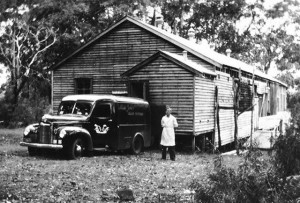
In the silent days, Owen Terry and Bert McLean ran a circuit which included Karridale, as well as Augusta, Witchcliffe, Margaret River and Cowaramup. In Karridale they screened in the hall and camped overnight. They set up an outdoor venue, similar to that in Augusta – screening onto a sheet hung on the back wall of the hall.
One of Allan Jones’ travelling picture show vans visited Karridale in the forties and fifties. Though this was a large, commodious hall, Jones described the seating as planks set up on packing cases, and liable to pinch or leave splinters!
The township of Karridale was completely burned out in bushfires in March 1961, and films were not screened there again.
Sources: Film Weekly Directory 1940/41 – 1957/8
Gail J. Cresswell, The light of Leeuwin: the Augusta-Margaret River Shire History , Augusta-Margaret River Shire History Group, 1989
Interview (Ina Bertrand & Irma Whitford): Allan Jones (1978)
Informant: Bill Stanes (1997)
Photo, Alan Jones in front of Karridale Hall, n.d, property of AMMPT
KATANNING
AGRICULTURAL HALL/ MECHANICS INSTITUTE/ TOWN HALL, 22 Austral Terrace, Katanning
The foundation stone for the Agricultural Hall was laid on 22 August 1896, and the building was officially opened in 1897. After a public meeting in 1899 the interests of the Agricultural Hall committee and the Mechanics Institute were merged and the hall became known as the Mechanics’ Institute and Public Hall. In 1903, after some controversy, it became simply the Mechanics Institute, and at that time the Roads Board was using part of the building for offices. This was probably the venue for the early presentations by travelling exhibitors, such as the Salvation Army Biorama Company (in September 1900, November 1900, September 1902 and February 1904), and Stevenson’s Royal Biograph (in January 1905).
In 1907 a new hall was constructed next door, with the Mechanics Institute renovated but no longer used as a hall. Merle Bignell (p.238) describes how the new building included: “four shops, a main entrance, a spacious cloakroom, a ticket office, a large stage and dressing rooms.” Inside, it had painted stage backdrops, a panelled ceiling and electric lighting. It was opened on 27 May 1907, in time for the Taits to show The Kelly Gang in July 1907, Robbery under arms in January 1908, and for the Corricks to perform there in December 1909. When West’s began their first country circuit in 1909, Katanning Mechanics Institute appeared on the list every Wednesday. Merle Bignell speaks of ´an ugly tank-like box’ (p.241) which had been installed as early as 1908 to house the projection apparatus.
From early in 1910, Kings Pictures were screening weekly in the Institute, managed first by H. Brown, then by J.Punch, who in 1912 converted the skating rink into King’s Hall. When that conversion was completed, King’s Pictures moved into King’s Hall and G.Galbraith took over the Thursday screenings in the Mechanics Institute, calling them Royal Pictures. By November 1913 the business was called Passmore’s Pictures, managed by S.H.Passmore, and by April 1914 it was Tivoli Pictures, managed by H.Delavale, which seems to have gone into recess for some time in 1914-15, but opened again in October 1915. It was renamed Katanning Pictures in March 1916, when it was taken over by Messrs Braund and Hales, and Katanning Pictures was run from August 1916 by the Returned Soldiers and Sailors Provident Association. One story has it that Robert Braund passed over the business during the war as a gesture to the war effort, and was distressed to find that after the war the group managing the films refused to restore the business to him. By now the venue was usually known as the Town Hall with screenings for the benefit of veterans, variously known as Provident Pictures and Repatriation Pictures, and lasting into the twenties.
One informant can remember that about 1920 there were free pictures for children on Saturday afternoons in the Town Hall, but no-one can explain why these were free… Several can remember either Miss Purkiss or Gordon Beck playing the piano for the silent movies. Piesse describes how his sons caught mice in the sheds on the farm and took them to the theatre to release during the pictures.
In November 1927 the front section of the hall was entirely rebuilt, providing a second storey at the front of the building, for new Municipal Offices and a bio-box and upstairs foyer and balcony for the hall. Town Hall Pictures and/or Repatriation Pictures continued, and in April 1931 sound films arrived, first at the Lyric, then at the Town Hall. Various private managements renamed the Town Hall. From November 1931 it was known as the Golden Gate Theatre, then, when Nelsons took over in December 1933, it was refurbished and re-opened as the New Plaza Theatre: in December 1935 the last night of Town Hall Talkies was advertised and the new Plaza Theatre was to open the following Tuesday, 10 December 1935. In April 1938, however, ´Town Hall Pictures’ were advertised as returning to the Town Hall where a complete new sound system had been installed: the following week, Katanning Pictures (Town Hall Pictures renamed again?) began advertising again in conjunction with the Lyric gardens. It is now very difficult to sort this out without new information coming to light.
The big hall is beautiful: high moulded plaster ceiling, panelled walls, jarrah floor. It has a large downstairs foyer, with a small room under the stairs now used for cleaning equipment but once the concession. At the top of the impressive staircase is a second foyer, with entrance to the lounge seating: the former entrance to a balcony above the verandah which once ran along the facade has now been filled in and the external balcony removed. The old supper room was under the stage, with entrance by stairs either side of the stage: these stairs are now covered by the stage extension, and the supper room is used as dressing rooms for stage presentations. The Katanning Town Hall crest is conspicuous above the proscenium arch. The rows of padded seats could be pushed back to the rear of the lower hall when the space was needed for dances.
In the forties, H. F. and Les Kanzler leased the hall for films and this permanent booking on the hall at weekends meant that any local dances had to take place at Broomehill. People who worked for Les Kanzler at this time as projectionists included Ross Page, Doug Brooks and Peter (Pud) Hanna. Kanzler screened two changes weekly: Wednesday night (sometimes a re-run), then Friday/Saturday (and occasionally Monday if the film was a blockbuster).
Ainslie Evans remembers that her father was ‘manpowered’ during the war to do community work, which took the form of acting as fireman at the cinema. The family lived eight miles out of town, so the government paid for the petrol: this delighted the children, as the availability of transport and free tickets meant that the whole family would go. Her father’s axe and torch were kept in a small cupboard near the door, and the first thing he did before each screening was check that all doors could be opened from inside.
Local residents remember the Town Hall pictures with affection. Friday was shopping day, when the families who lived out of town would come in for the day, complete their shopping, then have dinner at the local cafe, with everyone dressed up for the occasion. Sometimes the whole family would then go to the pictures: or Mum & Dad would drop the young people off at the pictures and go home themselves, leaving the young people to find a lift home with a neighbour, or perhaps Mum and Dad would go off to play cards and pick up the young people after the pictures. One young man, while he was still single, would ride his horse in four miles to town, tie it up at the stables (or to the rings on the verandah posts at the Federal Hotel), and walk up to the pictures.
There were usherettes to show you to your seat, though they were not in uniform. There was a certain social distinction between those who sat downstairs and those who paid the higher prices upstairs. Ainslie Evans remembers that while she was growing up, if you paid for yourself you went downstairs, but if you went with a boy he paid for you to go upstairs: that he was willing to do this meant the boy was really serious! If you were on your own and had not paid for a coveted upstairs seat, you could slip quickly upstairs at interval and appear on the balcony – a very innocent deception. Mrs Slater had a shop in the foyer, and this would be rushed at interval: one favourite was Silver Sammys (caramel covered with chocolate at one end), or penny chewing gum.
Babies could be left in the cloakroom at the entry – called the ´crying room’, though it was not the kind that allowed a parent to tend to a baby and still watch the film: instead, the fireman would call the mother out if the baby cried. Or you might leave the baby asleep in the car outside, in which case a slide would appear on the screen: ´Baby crying in KA43′.
There were no toilets in the hall. The men’s toilets were outside and behind the hall and men did not have to pay. The women’s toilets were across the road, and cost 1d: so the first person had to pay, then each person in the queue would keep a foot in the door so they could go in without paying. There were only four pan toilets in this block, and on a good night they would all be overflowing by the end of interval.
People could remember paying 5/- upstairs and 2/6 downstairs, or (earlier) 2/- upstairs and 1/2 downstairs. Children sat in the front on wooden seats. Adults sat in padded seats upstairs and wooden one downstairs: all closed automatically when you stood up, so made a great noise! Some people, such as the Hanna family, had permanently booked seats. There was no heating in the hall till recently, so everyone took blankets in cold weather.
Screenings continued at the Town Hall until the drive-in was built in 1961, then there was a long gap.
Roy Mudge started screening at the Katanning Town Hall on 23 January 1996 with Free Willy 2: he then screened every third Saturday till 9 July 1996, his last film being Dunstan Checks In. Steve Marvin then took over, and continues to screen irregularly. He brings his own projector and screens from the bio-box, using the screen on stage. He shows four or five times a year – mainly children’s films (though he did bring Shine).
Sources: Film Weekly Directory 1940/41 – 1966/7
Shire of Katanning, Municipal Inventory, site no A2218
Considine & Griffiths Architects Pty Ltd, Mechanics’ Institute Katanning Conservation Plan, August 1995
Ross Anderson (ed), Katanning: a century of stories. A collection of anecdotal short stories . Katanning Shire Council, 1988
Merle Bignell, A Place to Meet: a history of the Shire of Katanning , University of Western Australia Press, 1981, p.241
Great Southern Herald 1907-1920
Correspondence: Mrs Sandra Wilcox
Interview (Colleen Pead): Mrs Maria Harvey (1986)
Informants: Autumn Club (1997), Ainslie Evans (1997), Pat McGrechen (1997)
Limelight Picture Show Tours, http//:www.abc.net.au/limelight/docs/tours
Photos: 1 exterior, before 1927, b&w, Merle Bignell, A Place to Meet: a history of the Shire of Katanning, University of Western Australia Press, 1981, p.?
1 exterior (Town Hall), colour, 1997, Graeme Bertrand
2 interiors (Town Hall), colour, 1997, Graeme Bertrand 1 exterior (Mechanics Institute), colour, 1997, Graeme Bertrand
1 interior, colour, Ron Mudge,1996
1 exterior, b&w, 1926 (renovations in process), Katanning Historical Society
1 exterior, b&w, 1928 (renovations completed), Katanning Historical Society
Several exteriors and interiors, 1897-1995, b&w, Considine & Griffiths Architects Pty Ltd, Mechanics’ Institute Katanning Conservation Plan, August 1995
GREAT SOUTHERN RESIDENTIAL COLLEGE RECREATION CENTRE THEATRE, 22 Austral Terrace, Katanning
The Great Southern Residential College opened as a hostel for High School students on 2 October 1964. In the seventies, recreation facilities were built, including a large sports stadium, and at the back of this stadium a theatre was added. It had raked seating, holding 120, with a built-in bio-box and a screen with curtains. The project was started by Dennis McKenna and Troy Jones, and operated as a cinema for about two years.
In 1997, there were plans to re-start film screenings, both for the residents and as a fund-raising venture.
Sources: Informant: Pat McGrechen (1997)
KING’S HALL, Aberdeen St, Katanning
Holly’s shed faced Aberdeen St, but with a postal address in Austral Terrace: it was located behind the Mechanics Institute but slightly closer to Clive St. About 1909, this shed was converted into a roller skating rink, with a jarrah floor. In August 1912, J.A.Punch, who was managing Kings Pictures, moved from the Mechanics Institute to this roller skating rink, which had been converted for films, and renamed it Kings Hall. For some time Kings Pictures operated there in competition with various managements at the Mechanics Institute, though on at least one occasion (in October 1916) the Mechanics Institute exhibitor screened in the King’s Hall while the Institute was otherwise occupied (by a performance of The Mikado). Kings Pictures was taken over by Mr Lambert in August 1915, and it is not clear when regular screenings ceased in the hall.
In 1997 the building, faced with modern bricks, was still standing, though difficult to recognise as Kings Hall.
Sources: Merle Bignell, A Place to Meet: a history of the Shire of Katanning , University of Western Australia Press, 1981, p.248?
Great Southern Herald 1912-1916
Informant: Ainslie Evans (Katanning, 20 August 1997)
Photo: 1 exterior, b&w, 1997, Graeme Bertrand
LYRIC THEATRE, Austral Tce, Katanning
On 1 October 1925 the Lyric Theatre was opened, in Austral Terrace, opposite the railway station and between Albion and Broome Sts. At first, this was a gardens run in the summer months, with screenings in the winter being moved to the Town Hall. It was conducted at first by Repatriation Pictures and later in the twenties by George McLeod, who also owned the hotel.
It had the usual high fence and deckchairs. Katanning weather was less favourable to outdoor entertainments than some of the more northern parts of the state, so after only a short time (perhaps two to three years), the building was roofed. It was a large auditorium, with a foyer larger than usual in such buildings and a sprung floor which made it suitable for dancing. The deckchairs continued to be used inside the new building. In April 1931 sound films arrived, first at the Lyric, then at the Town Hall.
(Problems after this – there seems to have been some dispute in the thirties about the lease on the Lyric, but it is not clear why. Then there is confusion between the Lyric and the Town Hall over which one was renamed the Plaza and for how long.)
Local residents remember the Lyric operating in the thirties as a large multi-purpose venue, with the Town Hall the main cinema in the town. Saturday afternoon pictures at the Lyric cost children 6d, and their parents might also give them one penny to spend. On Sunday nights entrance to the films cost a silver coin donation, but on other nights the building was used for other purposes: Monday & Friday were auctions, Tuesday dancing, Wednesday skating. During film screenings, a fireman in uniform was always in attendance, and smoking was not allowed. However, smoking was allowed during other entertainments in the building, which was also used during World War 2 for boxing matches. One referee for these matches, and trainer for the local football club, was Dave Walters – a large and imposing man who also acted as usher in the cinema, ever ready to break up a disturbance or interrupt unseemly conduct by shining his torch on the culprits.
In 1930, Masters Pictures, run by Meggy Masters from Kojonup, ran the Lyric and the Town Hall for a short time, but, despite pleas in the Great Southern Herald for support from the local audience, the business failed, and was taken over by others. (Autumn Club members say this happened after World War 2, after Masters had won Tatts) The chief projectionist before and during World War 2 was Bruce Dunlop, and his assistants were Max Tonkin, Scott Wilson, Herb Wanke, and Ziggy Squires (who was killed in the war).
After its use as a cinema ceased, the building became a second-hand shop, then Wesfarmers, then in 1984 it was purchased by the BKW CO-op.. In 1997, the Lyric building was still there, though unrecognisable: the ladies wear section of the BKW Co-op had been built inside the theatre (like a Chinese box), so the ceiling of the old hall could still be seen inside the storage section at the back of the shop, and the roof of the old theatre was clearly visible from the rear of the building.
Sources: Post Office Directory 1913-1949
Max Bell, Perth – a cinema history, The Book Guild, Lewes, Sussex, 1986, p.110-11
Ross Anderson (ed), Katanning: a century of stories. A collection of anecdotal short stories . Katanning Shire Council, 1988, p.475
Everyone’s 9 May 1928, p.34
Great Southern Herald 1916-1938
Informants: Autumn Club (Katanning, 20 August 1997), Ainslie Evans (Katanning, 20 August 1997), Pat McGrechen (Katanning, 20 August 1997)
Photos: 2 exteriors, colour, 1997, Graeme Bertrand
STRATHFIELD DRIVE-IN, cnr Oxley St and Carew St, Katanning
This drive-in for 284 cars was built north of the town at the intersection of Oxley and Carew Sts, and opened on 8 February 1961, with a charity gala. Special arrangements had to be made for the installation of a diesel power generating unit, obtained from the SEC pending the arrival of the South West Power Scheme in the area. The drive-in was owned by Great Southern Drive-in Cinemas Pty Ltd, with Perth engineer (and partner in West Australia’s own sound equipment firm – Greater XL-Tone Amusements) R.Yelland as managing director, L.F(B?) Kanzler (brother of Bert Kanzler who operated the Town Hall/Plaza in Katanning?) as director-in-chief, and Morris A. Blake as director.
It had a children’s playground and a concession building that served meals (their fish and chips was particularly fondly remembered). In the early days, it was so popular that it was necessary to arrive early to be sure of entry. The usual drive-in stories circulate of attempts to avoid paying by covering children with a rug in the back seat or putting adults into the boot of a car.
After television arrived in the district attendance fell off and screenings were provided only three then two nights each week, till it closed altogether in the late seventies? In 1997 the fence was still standing, but apart from that only the concession/bio-box remained, incorporated into the house built on the site.
Sources: Film Weekly Directory 1960/61 – 1971
Public Health Department, building permit, Battye 1459
Film Weekly , 31 March 1960, p.9; 5 May 1960, p.6
Great Southern Herald , 3 February 1961
Max Bell, Kino, no.19, March 1987, p.10
Max Bell, Perth – a cinema history, The Book Guild, Lewes, Sussex, 1986, p.140
Informants: Autumn Club (1997)
Photos; 3 exterior, colour, 1980’s Max Bell
KELLERBERRIN
AGRICULTURAL HALL, Leake St, Kellerberrin
The Agricultural Hall was opened on the corner of Leake and Bedford Sts in 1898. It is of random stone construction, and has been used as a school, a court house, and most recently as the town museum. There is no record of this hall being used for picture screenings, probably because of the presence of the Olympia and later the Bijou/Regent. There are also no records of screenings in the new Town Hall, opened in Massingham St, beside the Shire Offices, on 3 May 1959.
Photo: 1 exterior (Agricultural hall), colour, 1997, Graeme Bertrand
BIJOU/ REGENT AND GARDENS, Massingham St, Kellerberrin
Perth entrepreneur Thomas Shafto opened a purpose-built cinema on 31 December 1929, in Massingham St, one building block from the south-east corner of Scott St. The building was designed by S. Rosenthal, built of local stone and leased to C. H. (Harry) Sherman. Across the road from the theatre lived a small boy who was bedridden at the time of the building of the theatre: Sherman was so sorry for him that he rigged up speakers so he could listen to the opening show. The local community had been invited to name the new theatre in a competition, with the prize to be a three months free pass. The theatre was duly christened the Bijou, and when the winner generously donated her prize to the local public school, to be awarded each week to the best pupil, no pupil to be allotted the prize more than once, the management matched her generosity by extending the award from three months to a year, and providing a similar pass for competition among pupils of the Convent school:
The building itself comprises an entrance vestibule flanked by shops, with cloak rooms next entrance to the theatre proper. The first floor is utilised as residential quarters for the lessee….The theatre is provided with a level floor for dancing and covers an area of 70ft by 40ft. The whole of the walls are finished white with curved fibrous plaster ceiling with ample perforated ventilation panels in same, secured to steel principals. One feature of this ceiling is the absence of steel rods across same, a defect common in many other halls. High windows, pivot-hung, are fixed on the side walls to give thorough ventilation. A roomy biograph box housed the projection plant, which is of the most up-to-date pattern…
Special attention has been paid to the lighting, the theatre being supplied with ornate semi-indirect lighting giving a soft light, and the outside of the building being flood lit.
A feature of the interior is the ornate proscenium and perforated panelling on sides of same and over the exit doors, relieving the simplicity of the interior. (Eastern Recorder, 3 January 1930)
Synchronised music and sound effects were provided from the first screening. There was also a stage and kitchen, making the premises suitable for all manner of community activities on those nights of the week when films were not being shown. At the opening, plans were to screen on Wednesdays and Saturdays, and to hold a weekly cabaret on Mondays.
In April 1931 the lease of the Bijou was purchased by E.P.Nelson, of Kalgoorlie, who appointed Eddie Lappin as manager. He re-opened the theatre, now named the Regent, on 9 May 1931, with a promise of talkies as soon as possible. Around 1937-8, he also opened a gardens at the back, with entry through the theatre, the screen located against the back wall of the theatre, and the bio-box at the far end of the gardens.
At the beginning of the war the venue closed for a short time till it was purchased in 1939 by Consolidated Theatres, who appointed as manager Arnold Cook – who had, as a small boy, listened to the opening of the Bijou many years before. During the war the theatre had its own lighting plant and two generators, one for lights and one for arcs. The old electricity plant was just behind the theatre.
Cook left the job for some time while working in Perth and was replaced by Les Fiedler, who re-located the gardens’ bio-box. He cut ports into the back wall of the theatre stage, so it was now possible to project from the stage onto the screen now positioned at the rear of the gardens where the old bio-box had been. This was more convenient for the operator, but it made the screen more vulnerable to high winds – sheets would occasionally blow off, though this did not happen during a screening.
Cook did not immediately come back to the Regent after his return to Kellerberrin. Then he borrowed money to purchase the lease from Consolidated and opened in his own right on 1 September 1948. The last screening of the Regent Theatre and Gardens was on 19 May 1963, only days before the opening of the drive-in.
In 1997 the building still stood, with alterations to the facade but otherwise intact, and was used as business premises and a dwelling.
Sources: Film Weekly Directory 1940/41 – 1962/3
Post Office Directory 1931-1949
Max Bell, Perth – a cinema history, The Book Guild, Lewes, Sussex 1986, p.120
Eastern Recorder 1928-1963
Interview (Ina Bertrand): R. Yelland (1985)
Informant : Arnold Cook (1986, 1997)
Photo: 1 exterior, 1997, Graeme Bertrand
HENWOOD’S HALL/ OLYMPIA PICTURES, Sewell St, Kellerberrin
At Kellerberrin, Olympia Pictures operated in the Olympia Hall through the twenties. The hall, on the east side of Sewell St between Hammond and Forrest streets, was owned by S.C.Henwood who also owned the electricity plant. Shortly after the Bijou opened in competition, Henwood sold his interest in the company to A.C.Hart. The new management renovated the Olympia, improving the seating and heating and providing new curtains and a new screen for the re-opening on 14 March 1930. They promised ´comfort and convenience’ for patrons:
Excellent music is being provided by a local orchestra and a Strine machine is being installed for effects and vocal parts of pictures. Long intervals will not be permitted, and screen songs are to be introduced to encourage the public to sing and be happy – in fact, the management is out to make patrons thoroughly enjoy every evening they spend at the Olympia. (Eastern Recorder, 14 March 1930)
Prices were reduced and plans were announced for the introduction of talkies. However, soon after this the Olympia burnt down.
Sources: Eastern Recorder 1928-1930
Informant: Arnold Cook (1997)
HILLVIEW DRIVE-IN, Massingham St West, Kellerberrin
This drive-in opened 24 May 1963, with a capacity of 150 cars. It was constructed and managed by Arnold Cook, who moved across from the Regent Theatre, which closed just before the drive-in opened. The drive-in screen was 60′ x 25’10”, 16′ above the ground. It was the first all-steel screen in the west, made by a local steelworks, with zinc anneal sheets pop rivetted to the metal frame, and it stayed perfectly square even during the Meckering earthquake. The drive-in was leased to another operator in 1983 and closed in June 1985.
In 1997 only the ticket box remained, and a house had been built on the site.
Sources: Film Weekly Directory 1963/4 – 1971
Public Health Department, building permit, Battye 1459
Max Bell, Perth – a cinema history, The Book Guild, Lewes, Sussex 1986, p.136
Max Bell, ´Western Australian country drive-ins’, Kino, no.43, March 1993, p.28
Eastern Recorder , 16 May 1963
Merredin Mercury , 1965
Interview (Ina Bertrand): Alan Larkin (1985)
Informant: Arnold Cook (1986 & 1997)
Photos: 2 exteriors, b&w, 1991 (Max Bell, ´Western Australian country drive-ins’, Kino, no.43, March 1993, p.28)
1 interior (biobox), b&w, 1991 (Max Bell, ´Western Australian country drive-ins’, Kino, no.43, March 1993, p.28)
4 exterior, colour . 1080’s , Max Bell
KELMSCOTT
KELMSCOTT HALL, Kelmscott
In the thirties, Saturday night was picture night in the Kelmscott Hall, run by the Hatfields. In 1949, R.R.Perrie, who was screening regularly in the Armadale hall and gardens, contracted with the Road Board to provide weekly screenings in the Kelmscott Hall for a period of five years: Saturday was still the regular picture night, but certain Saturdays (Easter, Show Week and the third Saturday in May, June, July and September) were excluded and would be replaced by another picture night for those weeks only.
Local historian Daphne Popham explains:
Kelmscott picture shows were held in the Kelmscott Hall, but never very consistently. Indeed, newspapers from the 1940s onwards printed speculation about the possibility of them starting, or re-starting, and published a number of plaintive enquiries. Mr Tilka showed films for a while in the ‘fifties, but to a rather irregular timetable.
Sources: Armadale-Kelmscott Road Board records, held by Armadale-Kelmscott Historical Society
City of Armadale, Municipal Heritage Inventory, no.165
Daphne Popham, First stage south: a history of the Armadale-Kelmscott district, Town of Armadale 1980, p.148
Informant: Armadale-Kelmscott Historical Society
KELMSCOTT OPEN AIR PICTURES, Kelmscott
This venue was on boggy ground, near the river, and operated during the twenties. Woolworths is now on the site.
Sources: Informants: Armadale-Kelmscott Historical Society
KENDENUP
HALL, Kendenup
This was listed as on the Kanzler circuit for a short time in the early fifties.
Sources: Film Weekly Directory 1950/51 – 1951/2
Photo: 1 exterior, b7w, n.d., Rhonda Glover, Plantagenet: ´Rich and beautiful’…: a history of the Shire of Plantagenet , WA, Shire of Plantagenet, 1979, p.123, plate 18
KENWICK
KENWICK PICTURES, Kenwick
There are references to picture nights being run for local groups such as the RSL Women’s Auxiliary as early as 1949, and to the Parents and Citizens Committee running regular weekly screenings in 1950. Bart Mott’s Star Entertainments Circuit visited the town from 1951/2 to 1952/3. Reeves and Howie are listed as proprietors of the Kenwick Pictures, in the local hall from 1953 to 1958. An Alfresco gardens was built in September 1957, but it is not clear whether this operated as a film venue, and if so whether it was in conjunction or in competition with the pictures in the hall. The hall was on the circuit run by F.Waldron from 1958/9 to 1960/61.
Sources: Film Weekly Directory 1950/51-1960/61
Coastal Districts Star 1 November 1956, 12 September 1957
South Western Advertiser, 30 June 1949, 11 May 1950
West Australian, 1954 – 1955
KINGSLEY/ GALAXY DRIVE-IN THEATRE, Goollelal Drive, Kingsley
The Kingsley drive-in opened 1973. The name was almost immediately changed to the Galaxy and from 1978 it operated as a specialist R-movie venue. By 1994 it was the only surviving drive-in cinema in the suburban district, and is still operating, with general product.
Sources: Kino, no.25, September 1988, p.23; no.49, September 1994, p.31
West Australian, 1973 – 2000
Photos: 2 exteriors, colour, 1997 (Graeme Bertrand)
KIRUP
KIRUP HALL, Station St, Kirup
In Station St, Kirup, on the north-east corner of the highway, is a large public hall. The external walls are timber with cement sheet above, and the roof is of corrugated iron. The whole structure is painted pale grey. There does not appear to be a bio-box, and there have been various additions (such as a supper room). The basic structure looks about 1950 vintage, but could be earlier.
Sources: Max Bell, Perth – a cinema history, The Book Guild, Lewes, Sussex, 1986, p.111
A.C.Frost, Baylya-Balinga: a history of Balingup, Donnybrook-Balingup Shire Publishers 1979, pp.49-50
KOJONUP
AGRICULTURAL HALL, Spring St, Kojonup
The Agricultural Hall was a simple brick structure, built in 1897 in Spring St, north of the barracks. It was almost immediately handed over to the Road Board, but was neglected enough that complaints were being made by 1900. In 1903, alterations were approved, which lengthened the hall by twenty feet, and added a stage, a ladies’ room, and a room for the use of the Road Board. These alterations were completed by April 1903, but in 1909 the Road Board moved into new separate offices. The Corricks stopped in the town in December 1909, presumably screening in the Agricultural Hall, and Tivoli Pictures presented at least one screening there in 1914.
The hall was later converted into a private home, and eventually demolished.
Sources: Merle Bignell, First the spring: a history of the Shire of Kojonup , Western Australia, UWA Press for Kojonup Shire Council, Perth 1971, pp.165, 194-5
Photos: 1 exterior, b&w, n.d., Merle Bignell, First the spring: a history of the Shire of Kojonup, Western Australia, UWA Press for Kojonup Shire Council, Perth 1971, Plate 36
KOJONUP DRIVE-IN, John St, Kojonup
Joe Rourke built the drive-in, at the end of John St, which runs to the east of Forsythe Rd. It opened with provision for 150 cars on 10 April 1964 and then Rourke closed his screenings in the hall.
The drive-in had Simplex projectors with 14″ arcs and a screen built by Melville Engineering. The cafe served take-away food before the show and at interval, and seats were provided under the cafe verandah. The venue screened four nights a week, with changes of programme on Wednesday, Friday/Saturday and Sunday. Rourke managed this drive-in himself, and placed managers in his other venues.
When Joe Rourke died in 1972, the drive-in was sold to Allan Jones of Busselton, and in the nineties had been on the market for some time: in 1997 the concession building was being used as a residence, but all the facilities were still in place (ramps, ticket box, screen), if rather down-at-heel.
Sources: Film Weekly Directory 1964/5 – 1971
Public Health Department, building permit, Battye 1459
Max Bell, Perth – a cinema history, The Book Guild, Lewes, Sussex, 1986, p.136
Max Bell, Kino, no.43, March 1993, p.31
Great Southern Herald , 10 April 1964
Interviews (Ina Bertrand): Allan Jones (1978), Alan Larkin (1985), Brian Rourke (1997)
Photos; 1 ,colour, 1988. Roy Mudge
3 colour , 1980’s Max Bell
MEMORIAL HALL, Albany Highway, Kojonup
The Kojonup branch of the Returned Servicemen’s League was formed in 1919, and local historian Merle Bignell (pp.211-214) describes how this contributed to pictures in the town:
These men, overwhelmed by their own good fortune, wanted most of all to establish some substantial monument to their fallen comrades and, with this in mind, land on the corner of the highway and Broomehill Road was purchased from the publican, Albert Sims, for £35.
It was suggested that an obelisk be erected there, inscribed with the names of all from the district who had died in the war. To raise the necessary funds various functions and raffles were held. Then some bright spark hit on the idea of running silent movies and this they did most successfully for almost two years.
They were shown in the Theatre Royal and Miss Ivy Krakouer and Miss F.Doig (later Mrs Levi Treasure) took turns to collect the door money and play the piano. The films and projector were managed by two pairs, Arnold Potts and J.E.H.Robinson (the resident Agricultural Bank inspector), or Levi Treasure and Tom Davis (a Boer War veteran who was farming on the Collie Road). Sometimes, the local police constable had to be present to turn disappointed customers away when there was a full house.
The inadequacies of the existing public buildings were quite obvious and when it was suggested that the money raised might be better spent on a large public hall in Kojonup which would meet the requirements of the district for many years to come, it was enthusiastically supported by the returned men especially when the idea of incorporating in the building a Hall of Honour, in memory of the fallen, was included.
Consequently a deputation of J.E.H.Robinson and Arthur Liddell waited on the Road Board at their meeting of 7 September 1921 to submit the idea and explain that they were prepared to hand over £300 they had collected to decorate the Hall of Honour. The Road Board members were sympathetic but finances were not abundant just then and they would not promise anything.
Negotiations between the RSL and the Road Board continued, leading to a referendum on 15 November 1924, which indicated overwhelming public support for the building of the new hall. Architect F.J.Coote of Kendenup was engaged, and builder A.Thomson of Katanning, and so the Memorial Hall was built on the Albany Highway, on the north-east corner of the intersection of Harrison Place. The foundation stone was laid on 11 November 1925, and the venue was officially opened on 20 August 1926.
P.J.(Joe) Rourke began weekly screenings in the hall in the early thirties. Rourke’s circuit was based in Kojonup in the early forties, visiting also Denmark, Cranbrook, Tambellup and Gnowangerup. After the war, it contracted to just Kojonup, Denmark and later Mount Barker, and all these venues were permanently equipped with Raycophone J3 projectors.
In the Kojonup hall, seats could not be booked, but four people always had their own reserved seat: these included Dr Abernethy and the matron of the hospital, so that if they were wanted for a medical emergency they could be found quickly.
Screenings in the hall ceased in the late sixties: Brian Rourke says they stopped when the drive-in opened in 1964, but Roy Mudge says both hall and gardens were still operating in 1968, and at that time the bio-box was built out into the hall on pillars. After screenings ceased, the projectors from the Kojonup hall went to Guildford Grammar School, where the Rourke boys had gone to school.
Sources: Merle Bignell, First the spring: a history of the Shire of Kojonup, Western Australia , UWA Press for Kojonup Shire Council, Perth 1971
Post Office Directory 1945-7, 1949
Great Southern Herald, 13 June 1914, 10 April 1964
Interviews (Ina Bertrand): Roy Mudge (1997), Brian Rourke (1997)
Photo: 1 exterior, colour, 1997, Graeme Bertrand
1 exterior, b&w, n.d. (Memorial Hall) Merle Bignell,First the spring: a history of the Shire of Kojonup, Western Australia, UWA Press for Kojonup Shire Council, Perth 1971, Plate 38
1 exterior, b&w, 1971, Merle Bignell, First the spring: a history of the Shire of Kojonup, Western Australia , UWA Press for Kojonup Shire Council, Perth 1971 Plate 39
KONDININ
KONDININ DRIVE-IN, Graham St, Kondinin
In December 1925 the first Kondinin primary school, which had been located on the north-west corner of the junction of Graham and Nichol Sts, was relocated to north Karlgarin. On 28 April 1966 the drive-in was opened on the site, with provision for 120 cars. It was operated first by Jack Llewellyn, and from 1970 by Graham Ford, till it closed as attendance was affected by television and video.
In 1997, the bio-box and concession building and ticket box were still there, but the site was otherwise derelict.
Sources: Film Weekly Directory 1968/9 – 1971
Shire of Kondinin, Municipal Inventory of Heritage Places, no.114
Public Health Department, building permit, Battye 1459
Max Bell, Perth – a cinema history, The Book Guild, Lewes, Sussex, 1986, p.136
Narrogin Observer, 28 April 1966
Informant: Brian Richard (1997)
Photos: 1 exterior, colour, 1986, Roy Mudge
KONDININ HALL, Jones St, Kondinin
The new Kondinin Hall was designed by architects Horsfall and Coote, and opened on 1 September 1934. It was a red brick building with a corrugated iron roof, and with the stage and kitchen constructed out of timber salvaged from the first hall in Rankin St. Paddy Baker’s film screenings, which had begun in the town before 1940, were transferred to the new hall and continued there till the mid-sixties, when they were taken over by Basil Colmer.
In the sixties, renovations were made at the front and back of the hall, leaving the old hall enclosed by the additions. Screenings ceased in the late sixties.
Sources: Film Weekly Directory 1940/41 – 1967/8
Audrey Webb, Kondinin-Karlgarin-Hyden: community, time and place , Shire of Kondinin 1988
Shire of Kondinin, Municipal Inventory of Heritage Places, no. 18
Photo: 1 exterior, b&w, n.d. Shire of Kondinin, Municipal Inventory of Heritage Places, no. 18
1 exterior, b&w, n.d., Audrey Webb, Kondinin-Karlgarin-Hyden: community, time and place , Shire of Kondinin 1988, p.171
KONDININ ROADS BOARD HALL, Rankin St, Kondinin
The Kondinin Hall was built in 1917 in Rankin St, near the corner of Gordon St, to a design of Alexander Rankin. It was administered by a local committee, until taken over by the Roads Board in 1927, and was used for all the social activities of the district. It was built of timber, with a corrugated iron gable roof, and a section added on one end for the stage and on the other end in 1929 for a bio-box, to make life easier for Paddy Baker, who screened there every fortnight on a Friday.
This building was demolished and the timber used for the construction of the stage and kitchen in the new hall, built in Jones St.
Sources: Shire of Kondinin, Municipal Inventory of Heritage Places, no.133
Audrey Webb, Kondinin-Karlgarin-Hyden: community, time and place , Shire of Kondinin 1988
Photos: 1 exterior, b&w, 1929, Audrey Webb, Kondinin-Karlgarin-Hyden: community, time and place , Shire of Kondinin 1988, p.160
2 , colour, interior, 1996 , Roy Mudge
KOOKYNIE
TOWN HALL, Cumberland St, Kookynie
Kookynie was one of the boom towns of the eastern goldfields – large enough by the start of the twentieth century to be gazetted a town in 1901. By 1905 it had a population of 1,500, substantial buildings and all major services: schools, a hospital, six hotels, shops, fire brigade, sporting teams, etc. Photographs of the Town Hall show a small corrugated iron building, with access in the front wall through a door flanked by two small windows. No evidence of a bio-box can be gleaned from photographs of the exterior, and there is no photo of the interior: no-one has mentioned the inside of the hall in reminiscences to the local historian. The Salvationa Army Biorama Company visited the town in October 1903, March 1904 and December 1904, but it is not clear which venue they used. Photos of the Town Hall exist in 1907 and 1909, so it was probably here that Bartlett’s Electric Biograph and Blind Entertainers performed in January 1907. However, it may have been the Mechanics Institute, which was the bigger hall, used for dances and parties.
Sources: Reminiscences of R.W.Bradstreet (unpublished)
Limelight Picture Show Tours, http//:www.abc.net.au/limelight/docs/tours
Photos: 2 exteriors (Town Hall), b&w, 1907 and 1909 (Goldfields Historical Society)
KOOLAN ISLAND
OPEN AIR PICTURES, Koolan Island
From 1951/2 to 1957/8 Film Weekly lists the Rowells of Derby as screening at Yampi Sound, which was probably Koolan and/or Cockatoo Islands. From 1963/4 to 1968/9, they are listed as screening at Koolan Island specifically, as part of their small circuit. I can find no further information about this connection.
Like Cockatoo Island, Koolan Island was a company town, built and owned by BHP, to house their shifting population of workers, varying from about 400 to about 800. The cinema was an open air venue, centrally located among the townsite amenities – behind the main supermarket, between the club and the swimming pool. As BHP operated continuous 24-hr rolling shift-work for all the workers, the cinema screenings were offered two or three times a week so everyone had a chance to come and see each film. It operated all year round: in wet weather a screening might be cancelled, or the audience would scatter for home when the rain became too heavy, but in lighter rain patrons would all rush for shelter under the biobox, determined to see the end of the movie.
The venue held about 150 canvas deckchairs, placed on a slope, with no perimeter fence. Entrance fees were small, and no-one seemed to mind if the children slipped in without paying at all. At the back, there was a small kiosk and a timber bio-box, built on poles. The equipment was old (about 1948 vintage) and unreliable: even the technicians from Perth could not improve it, because no spare parts could be purchased. By the end, the carbons had to be manually manipulated and the sound system could not be adjusted to real clarity, making the projectionists’ task quite difficult.
Projectionists were employed by the company: they booked the films, collected and prepared them for screenings, screened, then prepared the films for return to Perth. Pay was modest, but it was an interest outside work, and provided much-appreciated pocket-money. Terry Walters, who was one of these projectionists from 1987 to 1992, remembers:
There was one night when Edwin Bingwa and I were sitting there together and there was a particularly interesting part of the movie, and we both missed the first spot, and the second spot came on and there was a mad scramble, and we both lost it, and the screen went black! It was a really exciting part of the movie, so there was an uproar from down below. And we had watched a Peter Sellers movie the week before, where Inspector Clouzot had said “I fooooled you, didn’t I?” And we both turned around simultaneously and said “We fooooled them, didn’t we?”
While Cockatoo Island was operating, films were switched between there and Koolan Island, but after Cockatoo closed in 1985 the films came from Derby and were returned to Perth.
In the early eighties, it was usually half to three quarters full, with an occasional full house for a popular film like Crocodile Dundee. It was commercial television that finally made the cinema unviable. The town had always had some television: the ABC and mining television, which provided an occasional movie and some local news. These had not proved much competition for the cinema, but once GWN arrived the community began to lose interest in the cinema. Even eliminating the entrance fee made little difference, but the island manager wanted to keep it going. So in 1990 the Lions Club stepped in, taking over the Progress Association kiosk next door as their headquarters, and operating the cinema with volunteer labour and the support of the company for maintenance costs. It became a family venue, with a sausage sizzle available, so the whole family could come down for tea and a movie.
These screenings continued till the island closed in 1992. The whole town was demolished and the island reforested, leaving no trace of habitation.
Sources: Ina Bertrand, ‘Going to the pictures in the Kimberley, part 2′, Kino 73, Spring 2000, pp. 26-27
Film Weekly Directory 1951/2 – 1957/8, 1963/4 – 1968/9
Informants: Andrew Ensor (1999), Terry Walters (2000)
KOOLYANOBBING
HALL, Koolyanobbing
In the late sixties and into the seventies the Progress Association was listed as exhibitor in the hall. Before the distributors would provide a film supply, they asked the nearest 35mm exhibitor (Jim Goodin, in Southern Cross) if he had any objection. He replied that he had no objection so long as the Progress Association screened only films that he had already screened in Southern Cross.
Sources: Film Weekly Directory 1968/9 – 1971
Interview (Ina Bertrand): Alan Larkin (1985)
Informant: Jim Goodin (1998)
KOORDA
AGRICULTURAL HALL, Birdwood St, Koorda
The first hall in Koorda was a small timber construction built in the bush at the southern end of town in 1917: it was used for every community activity, including as a schoolhouse. Then, in 1924 the Agricultural Hall was built onto the eastern side of the old hall, facing onto Koorda St, and the old hall became the supper room. In 1958, the main street was completely re-aligned, so that that section of Koorda St was absorbed into a municipal precinct taking up the whole area between Railway St and Allenby Avenue, south of Birdwood St. A new, large, red-brick hall was built across the Birdwood St frontage of this precinct, facing onto Allenby Ave: the old main hall was demolished, and the first hall was renamed Pioneers Hall and became the centrepiece of a Pioneers Park.
In the thirties, the Koorda Agricultural Hall was on Paddy Baker’s circuit. Screenings took place weekly, on Sunday night after tennis and tea at Aitken’s place (Mr Aitken was then Chairman of the Roads Board).
The Koorda community remember Baker fondly: he gave the takings to charity occasionally, and never charged for children. Baker’s own memories of Koorda were perhaps less fond:
I got blown up in a garage at Koorda on Christmas Eve 1928 – smashed my elbow and I carried my arm strapped to my waist for over a year, paralysed. Except for a fortnight off at Wyalkatchem hospital I carried on as usual – changed tyres with one hand, drove the car, threaded the film on the machine and so on, sometimes using my nose as another hand. I had to do all this of course or there would have been no show and no living for me. (quoted in Broomhall, p.244)
“Baker films – as old as the industry” was spliced on the front of every programme. Baker had his own transportable projectors, which had specially-made bases that he left in the halls, and he carried modified projectors that he could screw onto the base. Then he bought a pair of second-hand projectors and installed them permanently in the hall: Len Thompson overhauled them and got them running perfectly.
The venue was not particularly comfortable: seating was on forms, only some of which had backs (some are still in the town museum), and people took cushions and rugs if they wished to be warmer or more comfortable. As film was the main entertainment in the town at the time, everyone went: children slept under the seats in the hall or in cars in the street, which was considered quite safe.
Baker screened in the old hall till it was pulled down, and in 1958 he moved into the new hall: from 1955 Len Thompson was assistant projectionist. Local farmer and amateur photographer George Lodge had occasionally run the pictures if Baker was not available, and tried to continue on his own after Baker stopped when the drive-in opened. However, Lodge had trouble getting film supply, and did not have a projectionist’s licence, so this attempt was short-lived. He was more successful when he started private screenings at his farm, with people sitting on hay bales in his shed or taking their own chairs.
Sources: Film Weekly Directory 1940/41-1945/6, 1950/51-1959/60, 1963/4-1964/5
Koorda Tourism Development Committee, Welcome to Corn Dolly Country, n.d.
Hellen Antonio-Crake, Koorda: a district emerges, Koorda Shire Council 1974
F.H.Broomhall, Mount Marshall: a history of the district and its people from the earliest times to 1942 , Shire of Mount Marshall, 1983, p.244
Informants: W. Aitken (Koorda, 27 August 1997), Marj Delane (Koorda, 27 August 1997), Len Thompson (Koorda, 27 August 1997)
Photo: 1 exterior (Pioneers Hall), colour, 1997, Graeme Bertrand
KOORDA DRIVE-IN, Koorda St, Koorda
The Shire of Koorda built the drive-in and paid for it with a loan of £2,500. It opened in October 1965 (Antonio-Crake p.84), on the south-east corner of Orchard St and what is now Aitken Rd (then Koorda St). Paddy Baker was the first lessee, and he employed two local men, Len Thompson and W.J. (Jim) Weymouth, to operate it for him.
Baker sent the films up from Perth, and Thompson and Weymouth would send them on to another of Baker’s drive-in circuit, at Trayning: Koorda opened on Friday and Saturday, and Trayning on Sunday. The venue, which held 110 cars, filled several times: Len Thompson remembers three overflow nights on The Sound of Music, and two nights on Gone with the Wind.
There was seating for about thirty inside the kiosk, and the people from the township often used this: cars would come from all around the district. The gates opened at 6 p.m., when the kiosk started serving meals, and the film would start at 8 p.m. Lil Weymouth was cook until she died, and then the kiosk was let out on contract, as it had not been a great money-spinner.
While they were on the local power supply the voltage might drop away 30-40 volts, and the conversion from AC to DC also entailed a drop in voltage: if the voltage dropped the automatic feed on the carbon arcs would also stop, the arcs would pull apart and the light would fade on the screen.
But it was not such technical problems that led to the demise of the drive-in: like most such venues, Koorda closed because of the drop in patronage after television. Where they had been getting about ninety cars on a good night, and perhaps thirty to forty even on a bad night, after TV they were lucky to get six people! So the venue closed about 1983.
In 1987 it re-opened: Steve Marvin of Perth screened once a month at first, then less regularly in the nineties, selecting dates to fit in with other community activities in the town. The Shire still owned the venue and renovated it in the mid-90s, so that it looked quite smart. The speakers hung from their stands in a sign of faith that vandals would not interfere, and patrons still travelled from other towns in the surrounding districts whenever a show was on. Chris Simmons reports that Dennis McKenna operated the venue monthly over the summer for several years, and that Chris was himself the projectionist for part of this time, coming up from Perth to screen at Mukinbudin on Friday night, then on to Koorda on the Saturday night. Chris was screening at Koorda over the summer of 2000-2001.
Sources: Film Weekly Directory 1965/6 – 1971
Public Health Department, building permit, Battye 1459
Hellen Antonio-Crake, Koorda: a district emerges, Koorda Shire Council 1974
Max Bell, Perth – a cinema history, The Book Guild, Lewes, Sussex, 1986, p.136
Max Bell, Kino, no.21, September 1987, p.22
Interview (Ina Bertrand): Alan Larkin (1985)
Interview (Peter Morris): Paddy Baker (1978)
Informants: W. Aitken (1997), Marj Delane (1997), Chris Simmons (2002), Len Thompson (1997)
Photos: 1 exterior, colour, 1997, Graeme Bertrand
3 exterior , colour, 1987 , Roy Mudge
2 interior, colour, 1987 , Roy Mudge
KUKERIN
PIONEERS MEMORIAL HALL, Kukerin
Dumbleyung was the base for a circuit in the twenties that went along the outer Great Southern railway and spur lines, operated by N.S.Harvey at first, but sold to Percy Byass in mid-1928. Unfortunately, his operation closed when he was burnt out at Kukerin only two months later and lost all his equipment and his vehicle. Around 1943, J. A. (Jack) Wilson, travelled in an ex-army ´pie truck’, in a circuit that included Kukerin and Newdegate, and around 1946 this circuit was operated by Vince Lucas and in the late fifties and early sixties by Paddy Baker.
Films began again much later, in the new hall, officially opened 11 May 1966, which had a built-in bio-box. Although no films have been screened there for many years, the projectors, now owned by the Progress Association, are still in the bio-box.
Sources: Film Weekly Directory 1940/41, 1958/9 – 1962/3
Informant: Alan Thiel (Lake Grace 1997)
Photos: 1 exterior, colour, 1997, Graeme Bertrand
1 exterior, colour, 1992, Roy Mudge
2 interior, colour, 1992, Roy Mudge
KULIN
KULIN DRIVE-IN, Johnson St, Kulin
In the sixties, the Shire of Kulin began investing in what local historian William Greble calls: ´amenities which could be called “luxuries” in the sense that they were not designed primarily to satisfy the economic necessities of life in Kulin.’ (p.215) This included a drive-in theatre, as well as a sporting pavilion and swimming pool.
The drive-in, opened 10 March 1966, and catering for 150 cars, replaced Paddy Baker’s screenings in the hall. This was one of those venues built on Shire land with Shire funding, then leased to a private operator, first Graham Ford, then Brian Richard (from about 1977), then Lyn Parker (of Lake Grace, from about 1980). Parker would run the same film one week in Lake Grace and the following week in Kulin.
William Greble (pp.237-8) describes how the drive-in contributed to changing social interaction within the town:
On evenings when films were shown, car-loads of young people would arrive, independently of their parents and up to an hour after the screening had started. Often, the film would be forgotten as they joked, drank beer, talked about the courting occupants of other cars or about the possibilities of ‘conning up’ girls at interval, or visited friends in other cars. At the interval, young people congregated in the refreshment kiosk, often staying there half an hour after the start of the second feature.
The venue closed in about 1983, which must have left a gap in the social life of the young people of the town.
Sources: W. E. Greble, A bold yeomanry: social change in a wheat belt district – Kulin 1848-1970 , Creative Research in association with Kulin Shire Council, Perth 1979
Film Weekly Directory 1968/9 – 1971
Public Health Department, building permit, Battye 1459
Max Bell, Perth – a cinema history, The Book Guild, Lewes, Sussex, 1986, p.136
Narrogin Observer , 3 March 1966
West Australian 30 July 1997, p.7
Informants: Lyn Parker (1997), Brian Richard (1997)
Photos; 3 exterior, colour, 1987, Roy Mudge
MEMORIAL HALL, Johnston St, Kulin
The first hall in Kulin was the Agricultural Hall, a timber building with a corrugated iron roof built in Day St in 1919. It does not seem that films were ever screened there.
The Kulin Roads Board was formed in 1926 and in 1928 the present hall was built in Johnston St, on the corner of Gordon St. The Municipal Inventory describes it thus:
The place is a brick construction with a corrugated iron roof. The hall is a pavilion with a gable roof. The hall entry and the Roads Board offices form a continuum across the Johnston St frontage, with a hipped roof. The spaces are not internally connected, a parapet wall separates them, and they each have a separate street entry. The parapet feature is rendered and painted a light cream colour. The remainder of the frontage is rendered upwards from a string course level at about 12 courses. An arched entry leads onto a covered porch on the south end of the frontage. A double door then opens into the former Roads Board office and Council Chambers. The main hall entry is also a covered porch, with two sets of double doors with fanlights above. The hall has a timber floor, decorative lined ceiling on the rake, and steps up to the stage, each side. The stage is located at the opposite end of the hall from the entry. Behind the stage is an extensive kitchen area extending the entire width of the hall, under the main gable roof. The building is an example of the architects still using European craftsmanship in the carpentry, brickwork and monumental decoration. It was a relatively rare occurrence at the time.
The foundation stone was laid on 20 March 1928, and the building was intended to be a memorial for World War 1. The rail connection to Narrogin was opened in 1915, and trains arrived each Thursday, which became market day and the day that films were screened in the hall. Kulin was on Paddy Baker’s circuit from 1928, and he put on a free show once a year on school sports’ day. Local historian William E. Greble describes how the Kulin Electricity and Cinematograph Co was owned and managed by local businessmen, who arranged that the town’s street lights could be turned off if the power was needed for the film screenings. Screenings in the hall ceased when Baker opened the drive-in in 1966.
In recent years, projection equipment was again installed, taken out of the Tardin Agricultural College, but in 1997 that had not yet been used.
Sources: Film Weekly Directory 1940/41 – 1964/5
W. E. Greble, A bold yeomanry: social change in a wheat belt district – Kulin 1848-1970 , Creative Research in association with Kulin Shire Council, Perth 1979
Shire of Kulin, Municipal Inventory of Heritage Places, nos.4,34
Max Bell, Perth – a cinema history, The Book Guild, Lewes, Sussex, 1986, p.112
Interview (Ina Bertrand): Roy Mudge (1997)
Photo: 1 exterior, colour, 1997, Graeme Bertrand
KULJA
HALL, Kulja
The town of Kulja grew up around the railway and in the thirties the community purchased the Kirup Hall and relocated it to Kulja. Paddy Baker screened there till the town died in 1971 when the Government sold off the houses built for the railway workers. The hall was badly damaged in 1979 by cyclone Hazel. Perhaps it was not rebuilt, as there is now no hall there – just the wheat bin.
Sources: Koorda Tourism Development Committee, Welcome to Corn Dolly Country, n.d.
Hellen Antonio-Crake, Koorda: a district emerges, Koorda Shire Council 1974
Max Bell, Perth – a cinema history, The Book Guild, Lewes, Sussex, 1986, p.112
Winifred Knapp, Who’d be a Farmer’s Wife, self-published?, n.d., pp.47-8
Photos: 1 exterior (1979), 1 interior (n.d.), b&w, Winifred Knapp, Who’d be a Farmer’s Wife, self-published?, n.d., p.47
KUNUNOPPIN
KUNUNOPPIN DRIVE-IN, cnr Wilson & Couper Sts, Kununoppin
This drive-in, with facilities for only fifty cars (the smallest in the district), was built by a group of local farmers. It opened in 1964, operated by J. Tilka, and was dismantled in 1983.
Sources: Film Weekly Directory 1968/9 – 1971
Public Health Department, building permit, Battye 1459
Max Bell, Perth – a cinema history, The Book Guild, Lewes, Sussex 1986, p.136
KUNUNURRA
OPEN AIR PICTURES, Coolibah Drive, Kununurra
Kununurra is the eastern-most township in the Kimberley, on the road between Wyndham and Darwin. The town was founded in the early 1960s, to house the workers building the Ord River irrigation scheme and the big dam now known as Lake Argyle. From very early, a small open air picture show, seating 150 people on canvas deckchairs in an area half the size of the present venue, was operated by the company which built the diversion dam (Christiani, Nielson and Clough): it was at that time a service provided free by the company to its employees.
The Kununurra Progress Association (KPA) then bought the venue from the company, and ran it as an amenity for the town, as well as to raise money for other community activities and amenities. They set the entrance fee at around $20 for a family. Dennis O’Brien, who worked for the PWD in the 1960s and 1970s, was co-ordinator for the Picture Gardens, on behalf of the KPA, from at least 1972. The co-ordinator usually did the projecting, but if he was not available they would find other people in the community: the projectionist was paid, but other members of the committee all worked voluntarily. There was not a great turnover in volunteers: people gave time generously and prided themselves on being on the gate.
The whole town went to the pictures – it was where people met. The films travelled around among the various picture gardens in the north (Broome, Derby, Hall’s Creek, Wyndham, Kununurra), and sometimes a reel would be mislaid, and they would ring up and ask where it was and could it be sent on in time for the next screening!
The venue was surrounded by a mesh fence, and the bio-box was at first built of timber, but became dangerously infested with white ants. Also, there was sometimes trouble with vandals in the venue and with thieves breaking into the cars parked in the street outside. So, about 1983, the KPA leased the block of land next door, re-fenced the larger area, relocated the screen from facing south-east to facing north-east, and built a new bio-box and a new canteen. They considered building a proper drive-in, but the cost of installation of speaker stands was prohibitive, so they simply opened up the larger area to cars, and kept broadcast sound for all patrons – whether on the deckchairs or in their cars. The larger venue also had a stage: a simple corrugated iron box, to one side of the screen and facing south-east. All sorts of performers used this stage – imported companies (ballet, opera, etc) and local theatrical performances, by both schools and amateur groups.
Many local activities benefited from money raised by the KPA in the Picture Gardens. The Ambulance Service was staffed by volunteers, but all its equipment and running costs were provided by the KPA, until the St John Ambulance took over in the late eighties. Many local clubs were supported with seeding grants of up to one third of their costs, and others were provided with establishment loans. In their annual distribution of funds, the KPA had sometimes up to $40,000 to allocate. They met regular commitments first (the Ambulance, and annual promises as clubs were developing), then distributed the rest on application.
In the early years of the venue, screenings were twice a week – on Wednesday and Sunday – but people complained because the children were falling asleep in school on Monday morning, so they changed from Sunday to Saturday (which did not please those who were involved in sport on Saturday). Screenings started at 7 p.m. because it got dark so early. The venue operated all year, regardless of weather. If it mizzled the screening continued: some people would shelter under the roof over the stage, and look ‘sideways’. But if it really rained hard the screening would stop and ‘pass-out’s would be given for a later screening. In colder weather the locals would wear long trousers and jumpers, and take blankets – the tourists, who usually came from colder climes anyway, did not seem to feel the cold.
Television came about 1983/4 and the income from the Picture Gardens slumped. Though its parent body, the KPA, went through a difficult time in the mid-80s, the cinema screenings continued irregularly, still run by the co-ordinator appointed by the KPA. From the mid-90s audiences began returning to the cinema, as people realised the social value of a night out. But it was no longer the only entertainment in town…
By the early 1990s young people had vandalised the venue (cutting canvas on seats, breaking into the bio-box, etc). Another problem was the lights on the nearby football ground, which intruded onto the screen: a compromise was worked out, that, if the pictures were running on a football night, the one light which most affected the screen would be turned off. Then, in 1998, a storm took the roof off the bio-box and the rain affected the equipment: it was touch and go whether the cinema could continue. The SES provided emergency cover, while the KPA decided what to do. Roy Pipe called a meeting of the old KPA, and established a steering committee, which called a public meeting. The 75 people who attended were told that the equipment had to be serviced, the bio-box rebuilt, and this would take a continuing commitment. One group of people wanted to see the land sold and the money put towards a new football club, but the KPA constitution did not allow this – the land had to be put to the use of the whole community. So a group (including many young people) decided to start up the KPA again, and to develop the Picture Gardens venue as a safe community facility for young people, incorporating the drive-in for evening use, but also with a skate ramp, basketball courts, driver training rinks, and cafes where the young people could meet but also learn hospitality skills. Tess Nekrasov (editor of the Kimberley Echo) was appointed cinema co-ordinator, and the venue was closed till volunteers could repair and renovate in preparation for re-opening. An agreement was reached with Sun Pictures in Broome, to ensure better film supply. Ron Tutt came up from Perth to provide a two-day intensive course for volunteers in how to maintain and operate projectors, and entered into an agreement with the committee to look after maintenance on their equipment. The venue re-opened in August 1999, with seating for 100 walk-ins and room for 100 cars.
Tess Nekrasov, who continues as a committee member of KPA, reports that:
in that first season in August-November 1999, the Picture Gardens screened two movies on Friday and Saturday nights, and recovered all previously accumulated debts. The venue now operates at a profit. Since 2000, the venue has operated on Saturday nights during the Dry season, usually with two films. Additional screenings are organised to coincide with key community events such as the Ord Valley Muster in May and NAIDOC Week in June/July. The KPA employs a part-time coordinator, Narelle Susac, and the facility is operating independently. Some film programming is shared with the Wyndham Picture Gardens… The grounds are also used for concerts and recently, the biggest-ever underage disco in Kununurra, run by the Blue Light committee, attended by almost 800 teenagers. A landscaping plan is now underway, with a bore providing water for a new lawn in front of the screen. Furthermore, the KPA is in the process of launching an arthouse film society that will use 16mm/rear projection equipment. There are still some members of the community who think we should sell the land and move elsewhere, but the sentiments from the wider community are unequivocally “stay put”..
Sources: Film Weekly Directory 1962/3 – 1971
Max Bell, Perth: a cinema history, The Book Guild, Lewes, Sussex, 1986, p.110
Ina Bertrand, ‘Going to the pictures in the Kimberley’, part 3, Kino 74, Summer 2000, pp.39-41
Interviews: Diane Donohue (1999), Margaret Lawson (1999), Tess Nekrasov (1999)
Informants: Neil Butcher (1999), Tess Nekrasov (2003)
Photos: 1 exterior (biobox, seating, screen), b&w, undated (early sixties?), Battye 816B, Series TB4596
3 exteriors, colour, 1999, Graeme Bertrand
KWINANA
KWINANA COMMUNITY ARTS CENTRE, Sulphur Rd, Kwinana
The Kwinana Community Arts Centre was officially opened on 12 March 1991. It contained a small theatre, which was occasionally hired for commercial film screenings by visiting exhibitors. In 1995, the Arts Centre purchased its own projection equipment and began regular screenings, every Friday and Saturday night, with additional screenings for special occasions like school holidays and seniors’ screenings.
MELODY DRIVE-IN, Office Rd, Kwinana Beach
The management of the Melody theatre (the Ray family) built a drive-in on the corner of Patterson St and Office Rd, on the boundary of Rockingham, and often informally referred to as the Rockingham drive-in. When it opened in 1961, the theatre had facilities for 450 cars, but this was reduced to 240 in 1971. In the eighties, it was sold to Jim Woods of Westralian Drive-ins, who installed new equipment, which was sold off after closure (some going to Murdoch University). Date of closure is not clear, but it was no longer in use by the mid-eighties. In 1997, the screen still stood in a sea of grass growing along the ramps.
Sources: Film Weekly Directory 1961/2 – 1971
Public Works Department, building permit (Battye 1459)
Kino, no.34, December 1990, p.24; no.35, March 1991, p.24; no.41, September 1992, p.27
West Australian 1964 – 1970, 1981 – 1982, 1985
Interviews (Ina Bertrand): Jack Bidstrup (1985), Lindsay Morris (1997)
KWINANA BEACH HALL, Kwinana Beach
A.E. and D.Briggs’ circuit visited Kwinana between 1954/5 and 1957/8, before the new hall was built in 1958 with a screen and film projection booth.
Sources: Film Weekly Directory 1954/5 – 1957/8
Max Bell, Perth: a cinema history, The Book Guild, Lewes,Sussex, 1986 p.31


